Work samples
-
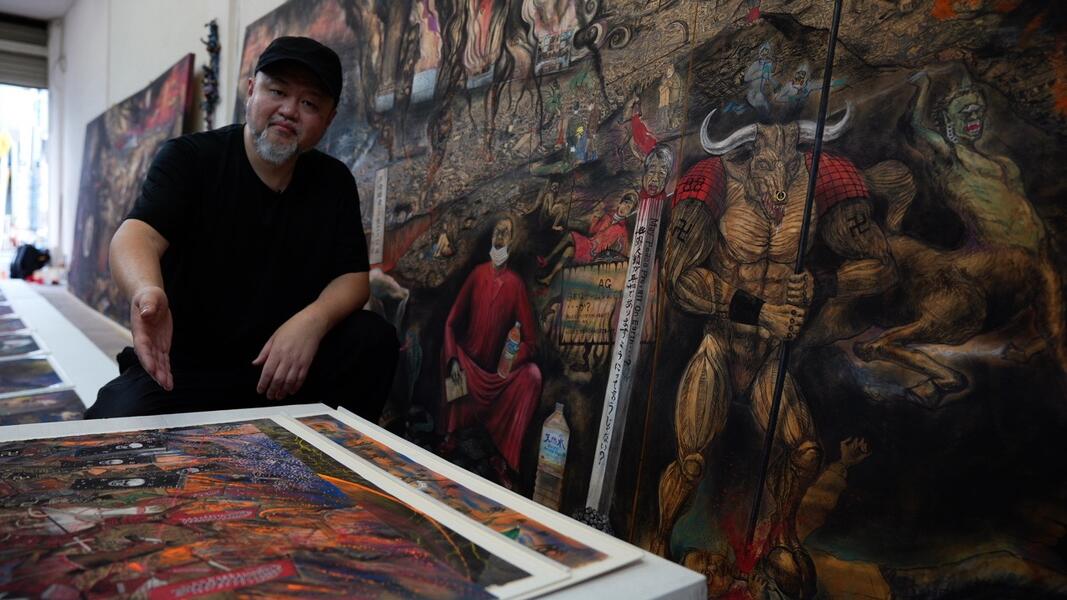 In Search of the Japanese Dante, to Tokyo and Back
In Search of the Japanese Dante, to Tokyo and BackIn Search of The Japanese Chiba is a result of a short trip to Tokyo to tell the story why a Japanese artist would dedicate himself fully to use Dante's Inferno as his palette to criticize society. As a result we want to go back to follow his passion on putting pressure on the Japanese government for its treatment of Fukushima inhabitants, where his family resides. We also want to examine how Japanese society deals with a critic like Chiba, who despite winning a coveted national prize has since been marginalized.
-
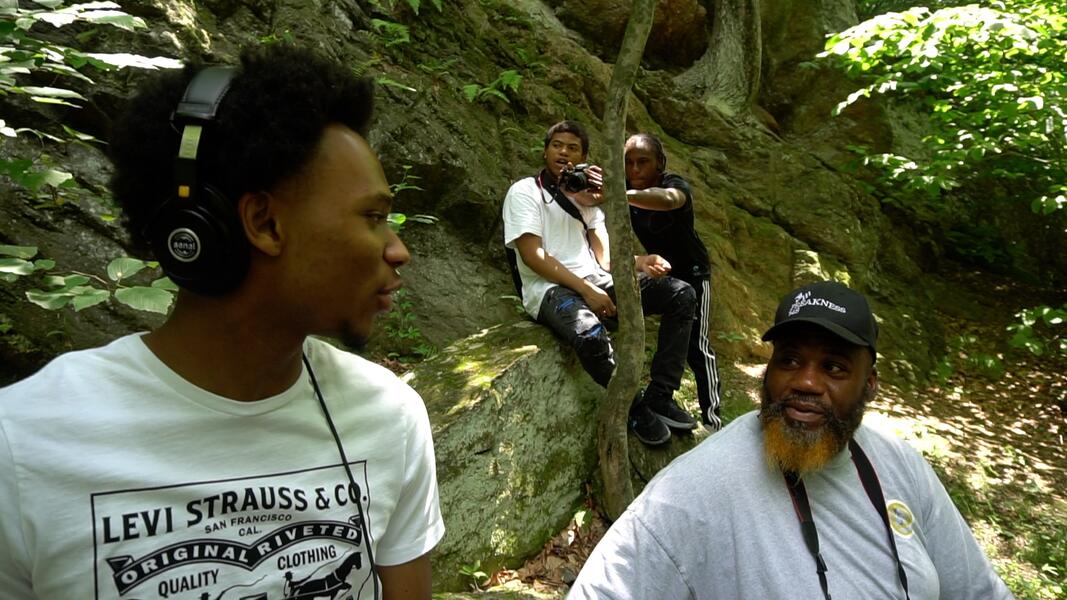 Off The Beaten Track, nature as a creative catalyst
Off The Beaten Track, nature as a creative catalystEarl Young's mentorship program has already been established with returning citizens and young adults to find community fishing and hiking in Baltimore unknown backyard. Now fused with filmmaking, the subjects both returning citizens and young adults are also the filmmakers. Their experiences are processed through the creative experience thus the sense of journey takes on an On The Road searching trajectory not just guaranteeing voice but also providing a benefit of partaking creatively.
About Charles
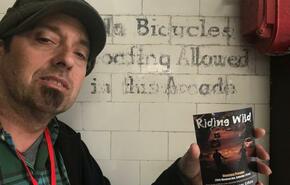
I am a documentary filmmaker born out of two decades spent as a print journalist writing for local and national publications.
But while most people think of documentary as an extension of conventional objective journalism with 60 Minutes as the dominating archetype, I gravitate to the genre’s original definition which goes like this: “Documentary is the creative treatment of actuality.” These are some magnificent marching orders that are a lot more expansive than… more
In Search of the Japanese Dante -- to Tokyo and Back
In Search of The Japanese Dante.
This film is work in progress of an open ended mission to go to Tokyo and get to know Chiba Kazumasa, the artist known as The Japanese Dante. The aim here is to create a short film that reflects that act of exploration, the act of learning about Dante as well as tell the story of an artist committed to telling a truth in his art even if it costs him his marketability in his home country. Working with Johns Hopkins Italian Literature Professor Ariel Sabber, who specializes on the works of Dante and Asian Studies Professor Jayantee, we had an opportunity to go to Tokyo to visit the Japanese artist who uses the iconography from the Inferno to fire off critically commentary on popular culture and on Japanese society in particular.. As Professor Sabber dove deep in Chiba’s approach, we worked on creating a film about the artist’s struggle to follow his passion on outing the hypocrisy and society’s complacency with violence and its satisfaction with its own ineptitude, knowing that the price he would pay. Despite winning a national award, he remains a marginal artist in Japan which only fuels his prolific work ethic.
He had a particular focus on the Fukushima disaster since he has family still dealing with the nuclear fallout. It our plan to go back and visit the region with him and to interview other artists also focused on showing the repercussions of the Fukushima disaster, all the while in staying with our original intent to make this film artist immersive. This means we will always go through the artist process, capturing the magic of making the art.
-
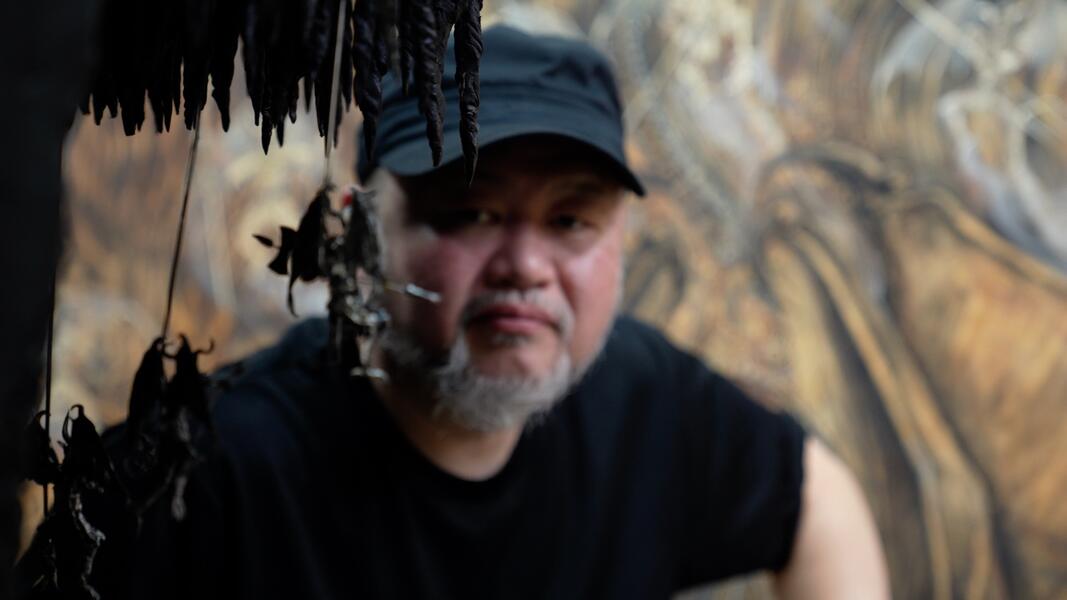 DanteChibaPortrait2.jpg
DanteChibaPortrait2.jpgChiba in his storage/workshop area takes us through the process of employing the iconography of Dante's Inferno to the political and social conflicts of modern day Japan. He also pulls from American pop culture and tradition Christian text with his own Buddhist background all mixed in to create a Baschian sensation.
-
Japanese Dante Ari Edit Trailer. Vrs. 3
We go deep into a Tokyo to find out the motives behind an artist who calls himself the Japanese Chiba. By following him through his collection we get an insider's view of Japanese culture
-
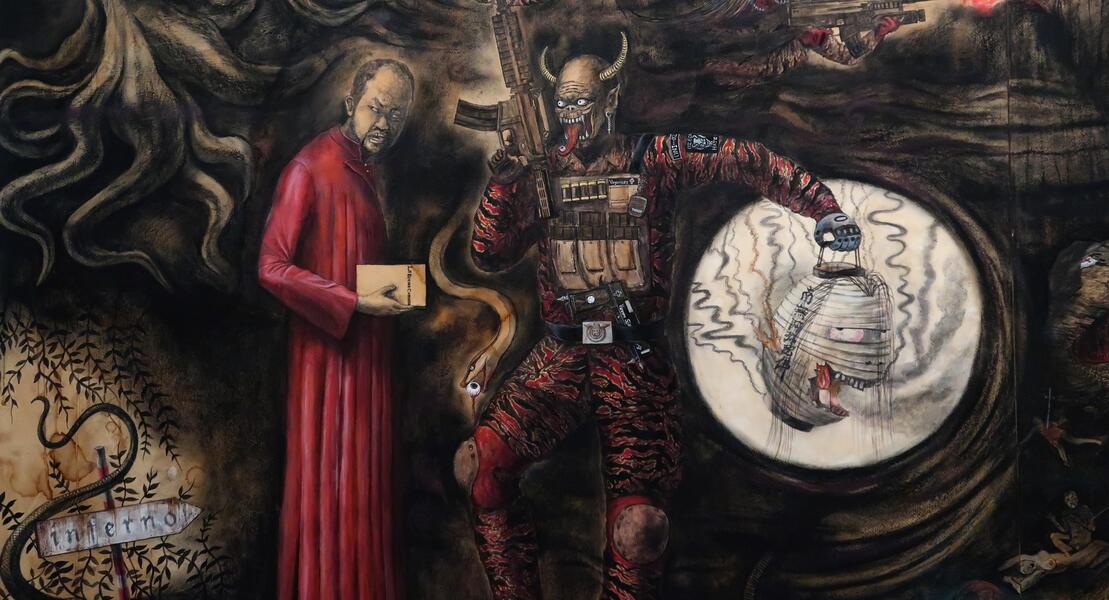 UltimateDANTE.jpg
UltimateDANTE.jpgHidden in Plain Sight is at the early stages of production. Pictured is a now picturesque falls, which once powered more than 50 mills throughout this greenway.
-
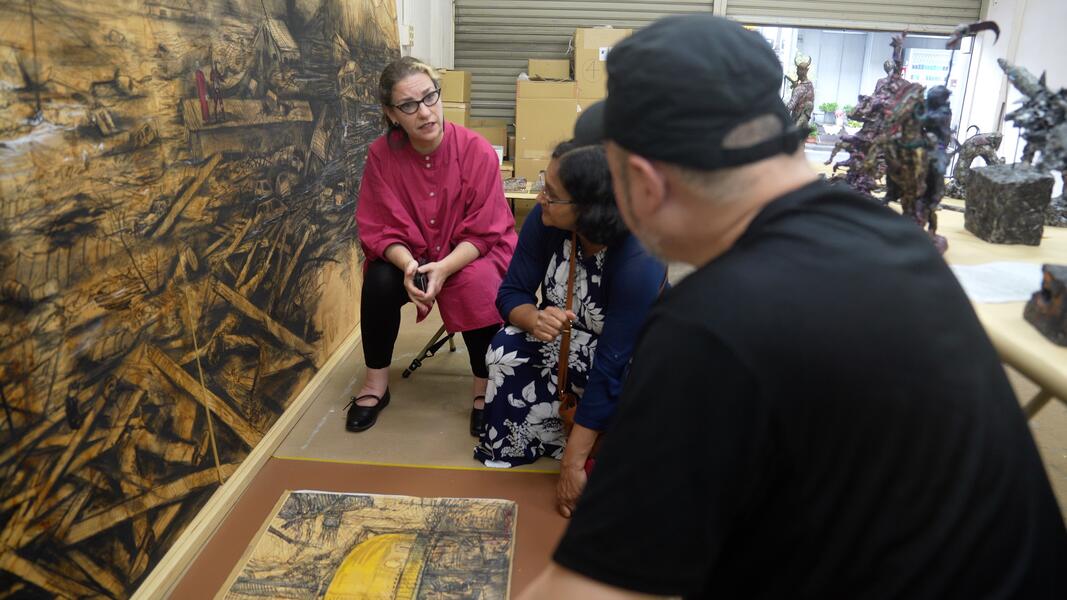 Ari talking to Chiba in Studio.jpg
Ari talking to Chiba in Studio.jpgAriel Saber went to Tokyo to document how Chiba isn't merely referencing Dante's Inferno, but rather drills deep into the literature using nuanced references to mix in with contemporary pop culture and Western Religious Iconography as well. At the same time, we as filmmakers aimed to tell his story as an artist and his tenuous role as a critic of Japanese society and to explore his world from his family life to his concern about his relatives still living in Fukushima
-
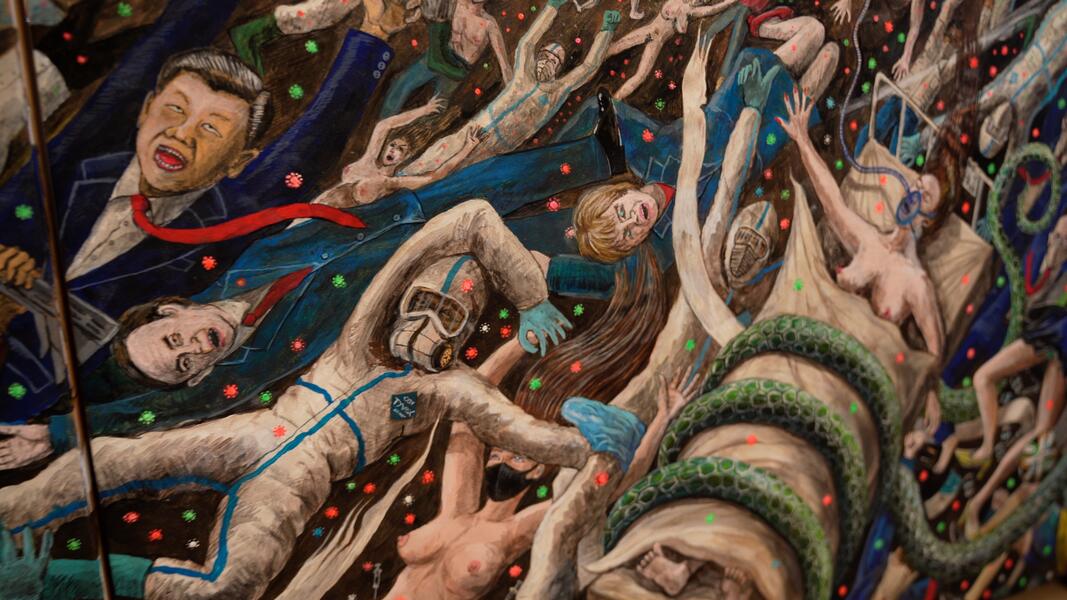 Covid Details.jpg
Covid Details.jpgWhat could easily be an entire painting in of itself is just a few inches of Chiba's wall sized installation focusing on the chaos of Covid as seen through the lens of The Japanese Dante.
-
Japanesse Dante First Cut Vrs. 3
In four days we got to not only know Chiba and his passion for telling his truth through the use of Dante iconography but we also got to see a Tokyo for a locals point of view from his dinner table with his family to the side street cafe and bars to his favorite municipal garden.
-
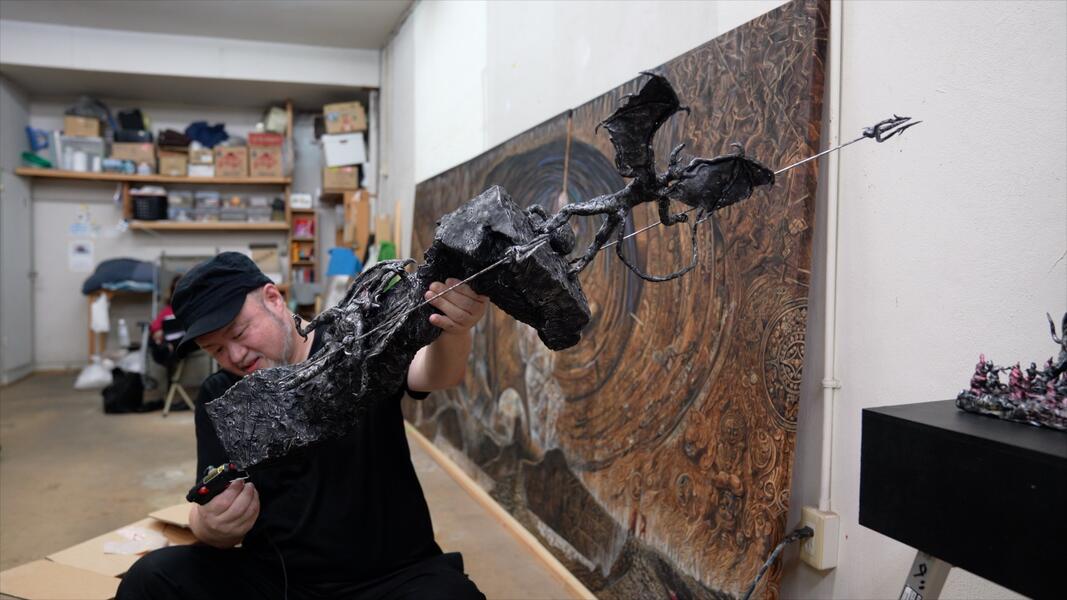 working on devil statue.jpg
working on devil statue.jpgChiba also is a prolific sculpture many times isolating the details found in his paintings. Behind is Hell through the Dante lens. While formative in scale, the artists pays painstakingly attention to the details as was depicted in the earlier slide of his Covid painting. We want plan to go back to Japan this year to film him painting.
-
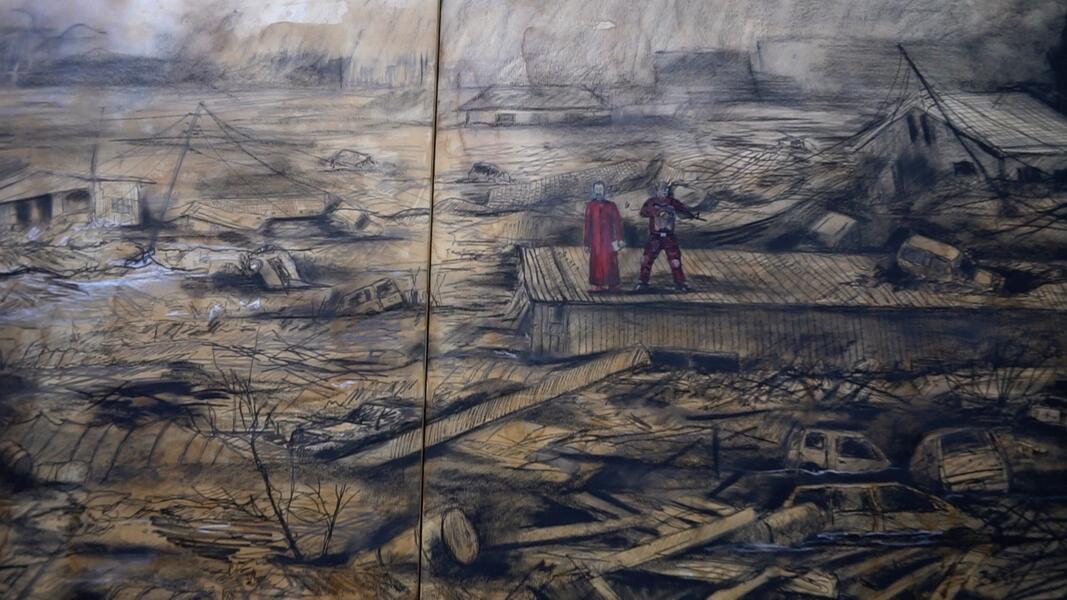 Dante and Fukushima.jpg
Dante and Fukushima.jpgWith extended family including grand parents living in Fukushima, Chiba is vested in what he sees as a inexcusable breakdown of the government's response to the nuclear plant disaster and its responsibilities in telling the truth about the environmental threat that still exists. He had done a series of pantings and there are plans to revisit the region
-
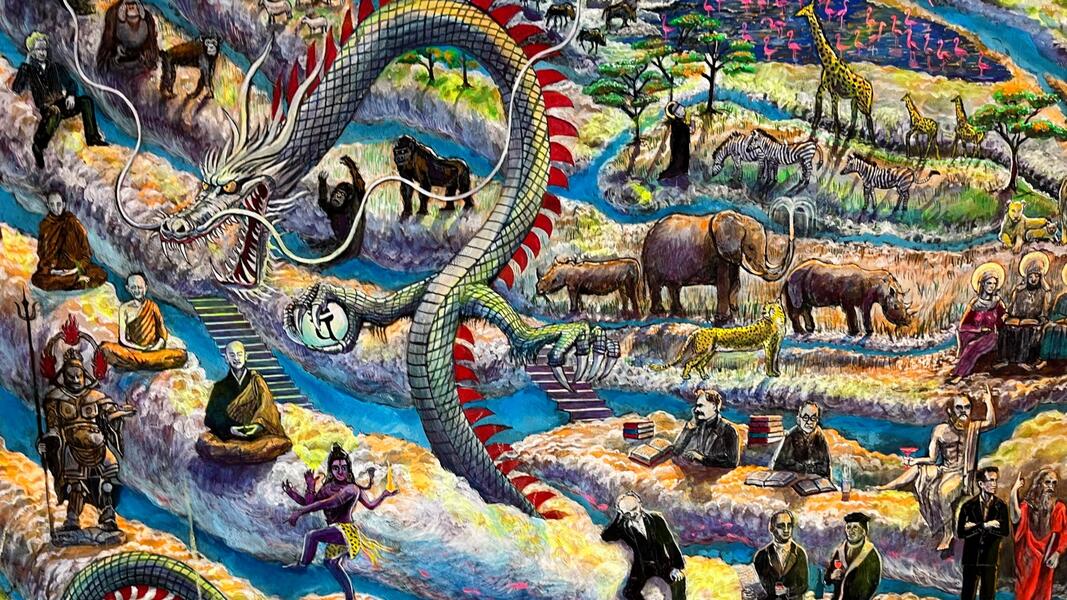 Dragon Heaven.jpg
Dragon Heaven.jpgChiba Kazumasa's tones burrow down into earthy, rich colors to emphasize the intense urgency of foils of life, but when it comes to Dante's Paradise not does his palit switch to an optimistic rich pastel, but his still takes on more vivid lines as he dares to draw a world that he dreams that could be possible, a place of harmony between humans and beasts, where historic figures of thought and inspiration intermingle.
-
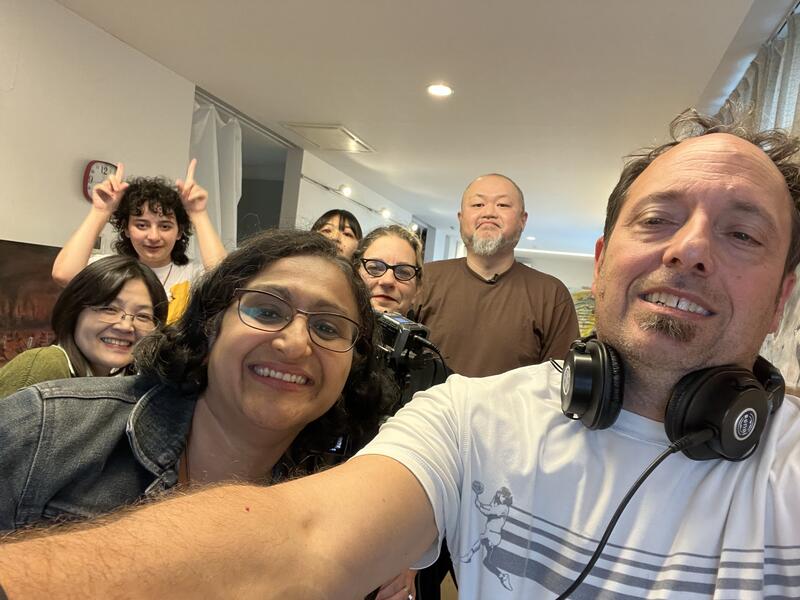 Crew.jpg
Crew.jpgYes this is a selfie, but it's done to show the bond that has developed between the crew and Kazumasa's family all pictured here. Through following The Japanese Dante will have also steeped into the culture and experience that we hope to further explore on our return trip.
Community Filmmaking, an experiment in storytelling. In other words trying to get it right.
Off The Beaten Track, a communal filmmaking experiment, fusing visceral exploration with the quest to tell the story to create the sense of journey.
Among documentarians there has been a lot of discussion on best practices when telling stories of communities, especially those who are vulnerable. It has been acknowledged that privilege carries bias, that the process of telling stories, creates a power dynamic between the creator and the subject, who traditionally have little say on editorial decisions. Of course there is also the critical eye and the talent of the filmmaker and the valued sanctity of pursuing vision without being compromised by personal and social concerns. As an independent filmmaker I have found myself pinched in this conflict. This year I created a communal filmmaking approach working with Earl Young's mentoring program, featuring returning citizens all of whom have been incarcerated for more than twenty years, and their charges, a dozen teenagers and twenty somethings from across Baltimore. Almost all struggle economically and many are facing the trauma of crime, poverty and the lack of opportunity.
Together we've created Off The Beaten Track, where mentors and youth go on hikes, fishing, work with horses, museums, to experience the transedance of the outdoors but also to learn the filmmaking technique. Thus Off the Beaten Track lives on several levels. Level 1, Off The Beaten Track creates a safe space, a respite, a way to feel inspiration, creativity and a sense of community. But with cameras comes the possibility of exposing the other levels. The filmmakers start out capturing their experiences and interaction with say the solitude of nature or awe of standing on the grounds where Harriett Tubman started her journey to freedom. But over the year we turned the camera from the outdoors onto the interior landscape --- the emotions and struggles of what we are facing. All the while we want to include the act of storytelling itself, acknowledge the construct. This has been an evolving process from one session to the next. Each season features seven workshops and a film. There has been three sessions funded by The Johns Hopkins Initiative Baltimore Films Arts Program, which unfortunately is about to close. In anticipation, I have created a non-profit, Grassroots Media Makers, to continue the work. As we finish our third session, our participants have brought their cameras into their lives, creating vignettes that will be woven into the sense of journey,
-
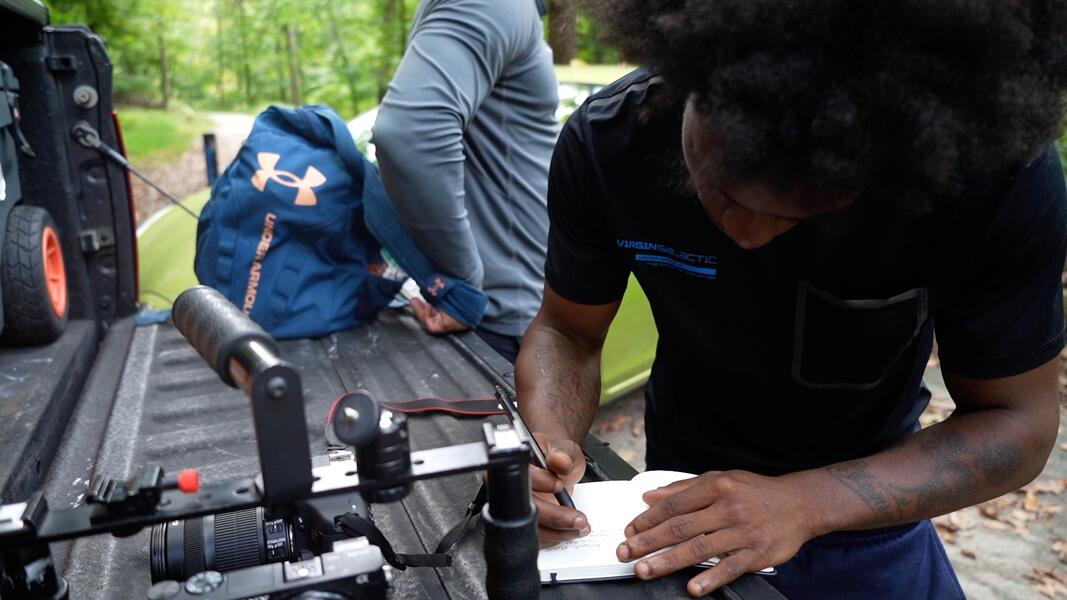 In the field
In the fieldRob Shearin, filmmaker, unpacks impressions after a hike in Leakin Park, the third largest wilderness East of the Mississippi, a place he and the others never knew existed.
-
Off The beaten path TRAILER vs 2
This trailer focuses on the experience of utilizing The On The Road approach, where the sense of exploration, generates the creative experience and with cameras in hand, we aim to capture it as well as ourselves as creators.
-
off the beaten track Vs. 3.3
This fall our filmmaking team utilized the On The Road approach, travel and exploration as part of the creative process, to record its impact on their perspective as well as emotionally. We traveled to Leakin Park woods, went fishing and then to the Harriett Tubman Underground Railroad. The idea was use the experience as catalyst for creativity as well as to capture the experience of discover in "ones own backyard"
-
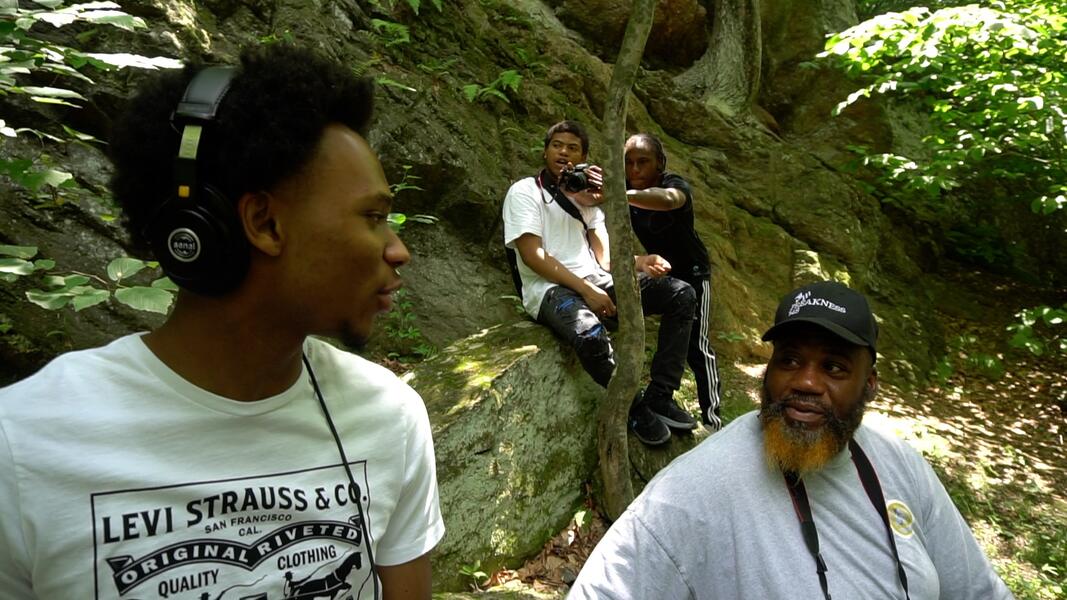 Mentorship and the creative process
Mentorship and the creative processWhat started as a mentorship program where returning citizens take young adults on simple nature based excursions to create bonding and fellowship has been part of a filmmaking approach where the subjects are also the creators. The act of filmmaking has also taken on the mission of the excursions in that making the story processes the sense of community they are finding on this journey.
-
Deisha Counsin and mentor
Deasia Alleyne is one of the more quieter participants, but this winter she took a camera home and offered up this exquisite appreciation of finding herself as a role model for her family. She serves as an example of where we are heading with giving folks cameras to dive internally while we continue to head Off The Beaten Track.
-
Off The Beaten Track objectives
Co-lead creators Earl Young and Charles Cohen speak of the objectives of combining and outdoor mentoring program with filmmaking, turning the camera over to the subjects and the transformative process of using nature as inspiration.
-
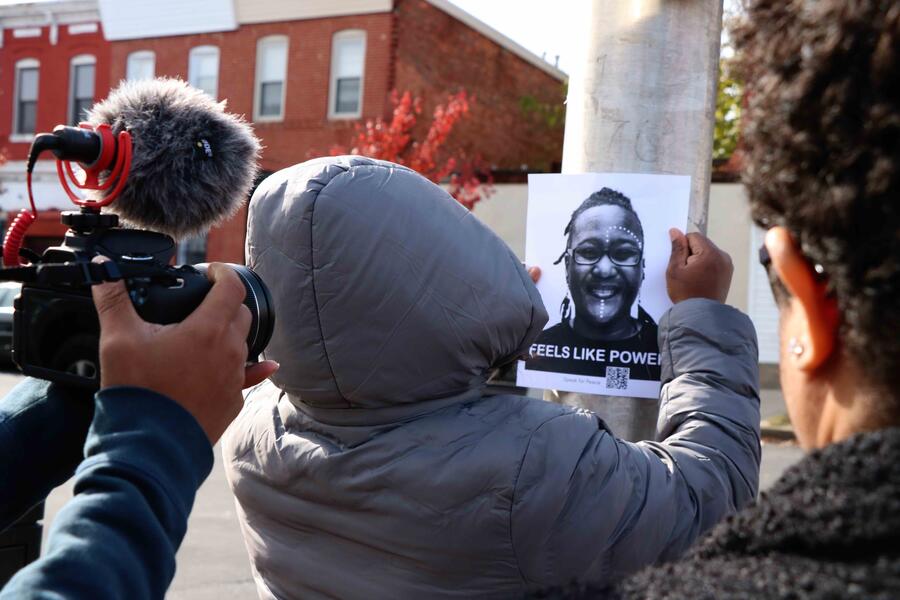 Posting posters.jpgThis is how we were able to distribute the Speak for Peace videos, such as the Errika Bridgeford video. Students posted them through the city. Each poster had a QVR code that people could access through their phone. The MTA created a large bus Stop poster of Errika's video.
Posting posters.jpgThis is how we were able to distribute the Speak for Peace videos, such as the Errika Bridgeford video. Students posted them through the city. Each poster had a QVR code that people could access through their phone. The MTA created a large bus Stop poster of Errika's video.
Into The Light, A look into Baltimore's Ballroom Scene
This documentary dives into Baltimore's Ballroom culture as several houses prepare for an elaborate ball held at the exclusive Peabody Library. A collaborative project with Johns Hopkins University, I was brought in as editor and in-the-field unit director, where I ended up shooting 99 percent of the behind the scenes footage before and after the ball.
The six months spent with Keith, Marquise and Londyn demonstrates power of dedicated storytelling to overcome obstacles such as distrust, motives and misunderstandings.
Despite this scene being quite underground (at least in Baltimore) I have been given amazing access, which is due to a mutural appreciation of the Ballroom's artform and our love of Baltimore. I continue to work with all three to this day.
-
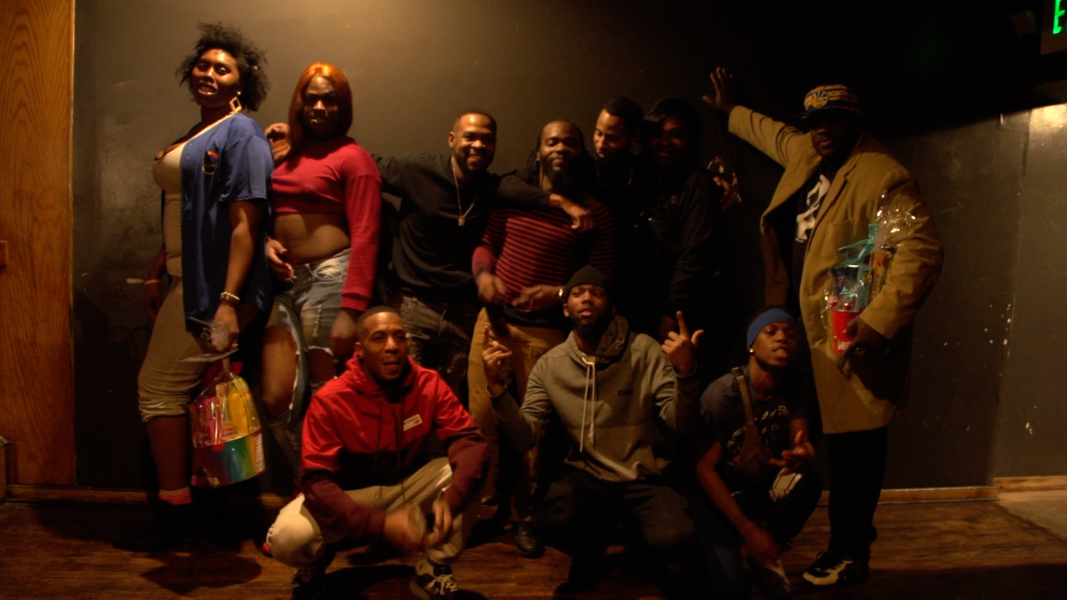 https://www.youtube.com/watch?v=Z4SScQUAoBMThe House of Ebony arranged to have a house meeting and a ballroom rehursal at Club Bunns, a major spot for decades, before it closed down. https://www.youtube.com/watch?v=Z4SScQUAoBM
https://www.youtube.com/watch?v=Z4SScQUAoBMThe House of Ebony arranged to have a house meeting and a ballroom rehursal at Club Bunns, a major spot for decades, before it closed down. https://www.youtube.com/watch?v=Z4SScQUAoBM -
Embedded video media on Vimeo
password glitter This is a near final cut of "Into The Light" barring some sound mixing and color correction. This was a two year editing experience with me returning to the subjects after the Peabody Ball to expand upon storylines.
-
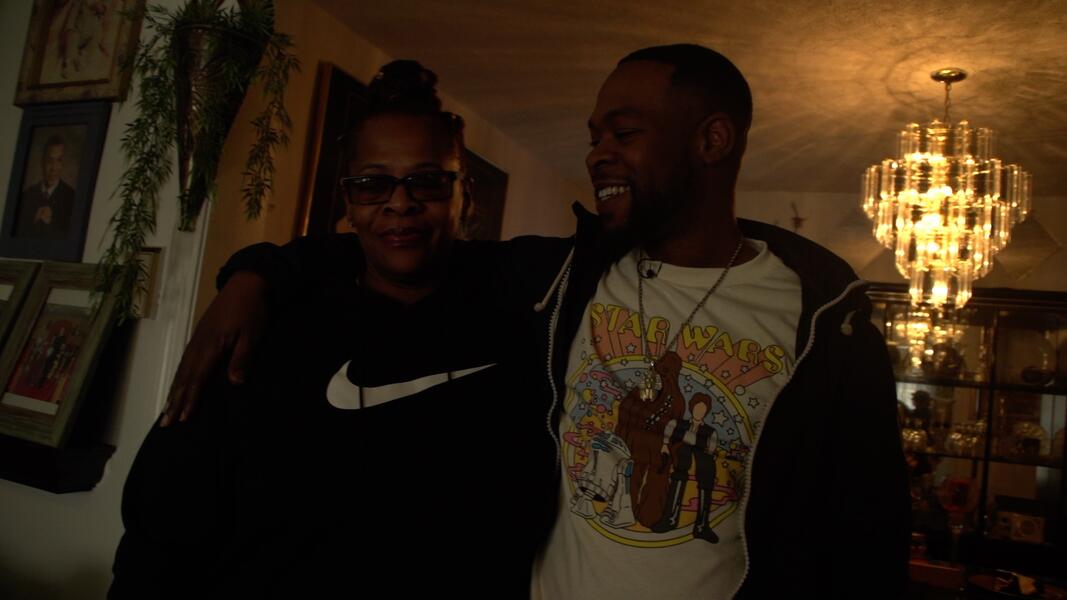 Keith and Mom.jpgKeith and Mom Sheri Holt. By following the main subject Keith, we were allowed to get an assortment of detail both big and small adding more real life richness to this film
Keith and Mom.jpgKeith and Mom Sheri Holt. By following the main subject Keith, we were allowed to get an assortment of detail both big and small adding more real life richness to this film -
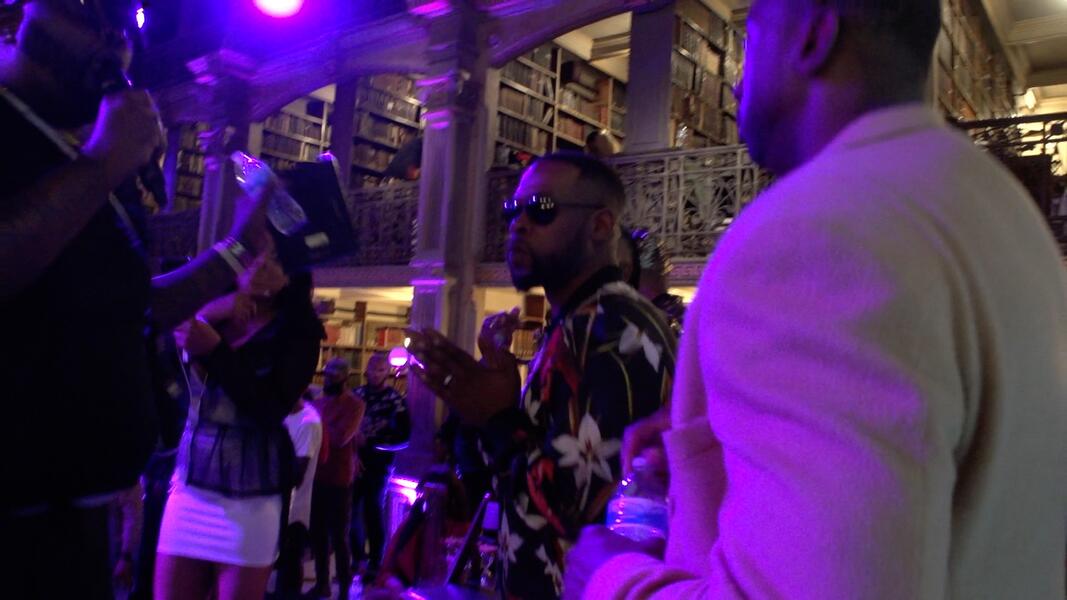 Keith at Ball.jpgKeith, House Father of Ebony, at the Peabody Ball that he helped coordinate. There were eight camera people covering the ball.
Keith at Ball.jpgKeith, House Father of Ebony, at the Peabody Ball that he helped coordinate. There were eight camera people covering the ball. -
 Londyn Portrait.jpgLondyn of the House of Moyglare, was one of the coordinators of the Peabody Ball.
Londyn Portrait.jpgLondyn of the House of Moyglare, was one of the coordinators of the Peabody Ball. -
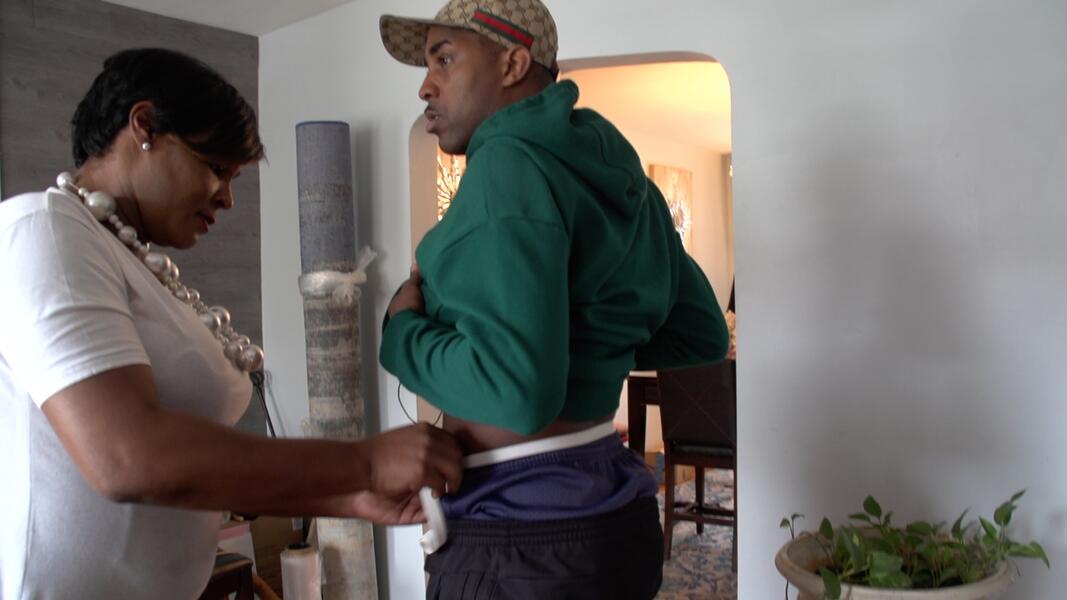 Marquise and seamstress.jpgSeamstress Kinera puts the last touches on Marquise's costume for the Peabody Ball.
Marquise and seamstress.jpgSeamstress Kinera puts the last touches on Marquise's costume for the Peabody Ball. -
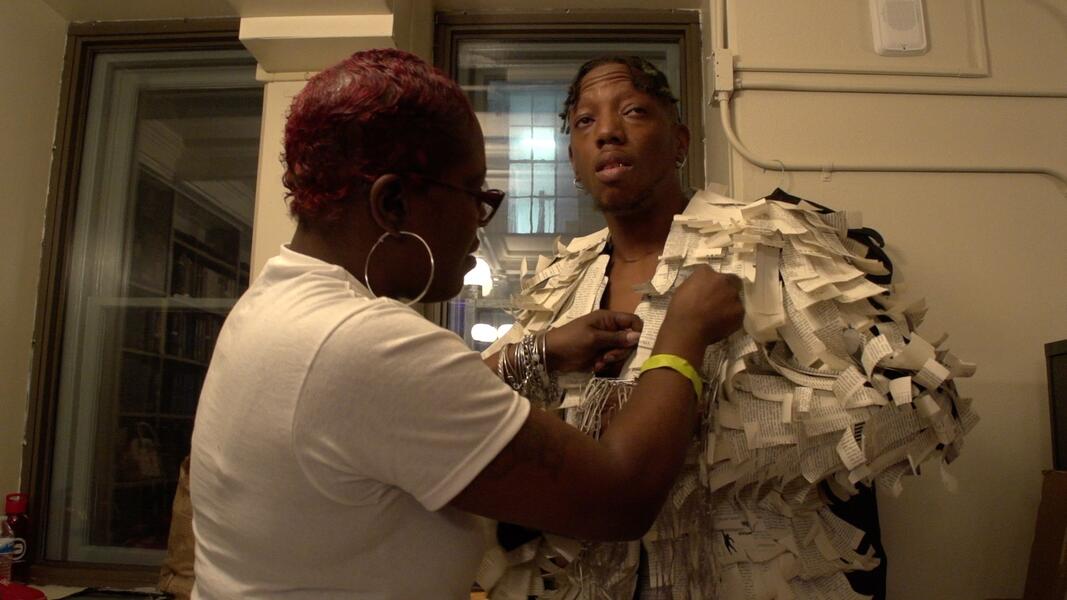 Book Dress .jpgKinera prepares her book dress, made from clipped and curled pages for the runway.
Book Dress .jpgKinera prepares her book dress, made from clipped and curled pages for the runway. -
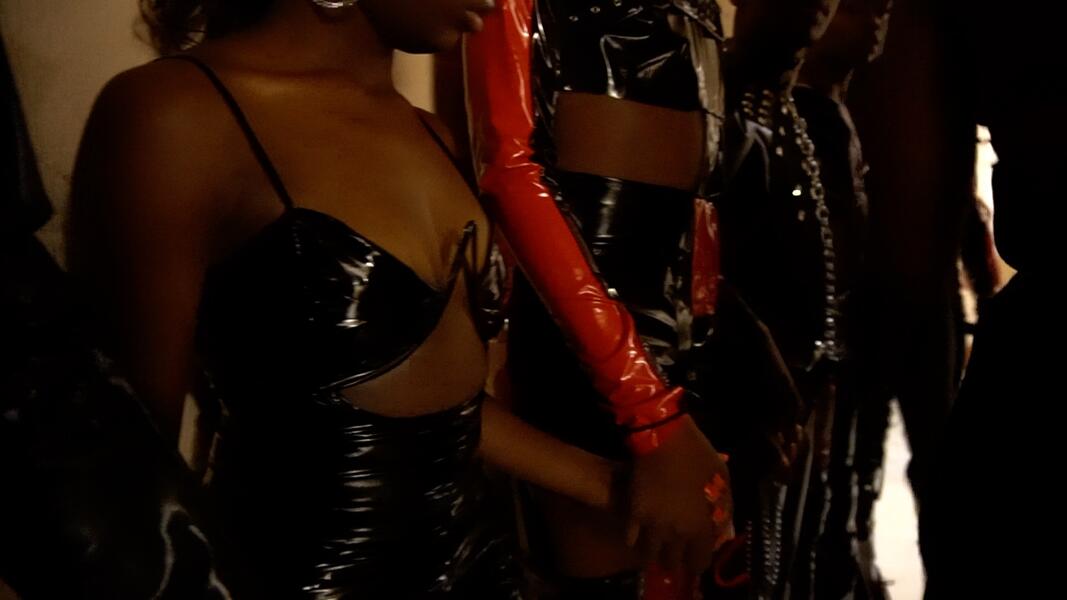 Prayer Circle.jpgMarquise's Dance Crew hold a prayer circle before their show at a rented Mercy High school Hall
Prayer Circle.jpgMarquise's Dance Crew hold a prayer circle before their show at a rented Mercy High school Hall -
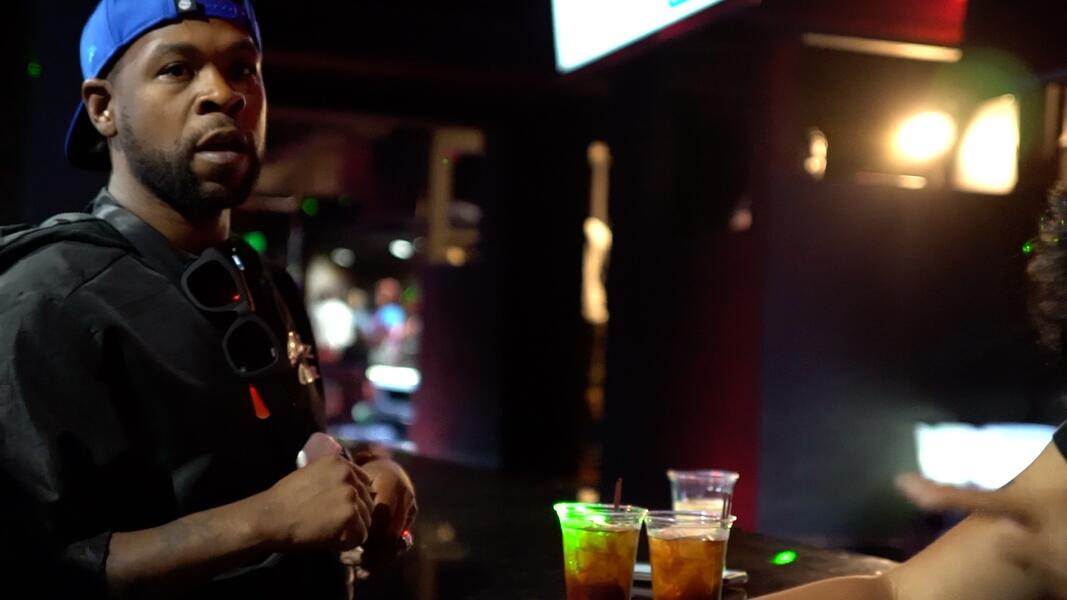 Keith A list.jpgKeith at his monthly A-List Party held at the former 2 O'clock Club once owned by the famed Blaze Star.
Keith A list.jpgKeith at his monthly A-List Party held at the former 2 O'clock Club once owned by the famed Blaze Star. -
https://www.youtube.com/watch?v=Z4SScQUAoBMTrailer 01Trailer for Into the Light. A Journal through Baltimore's Ballroom featuring the House of Ebony.
Opera: Postcard from Morocco
-
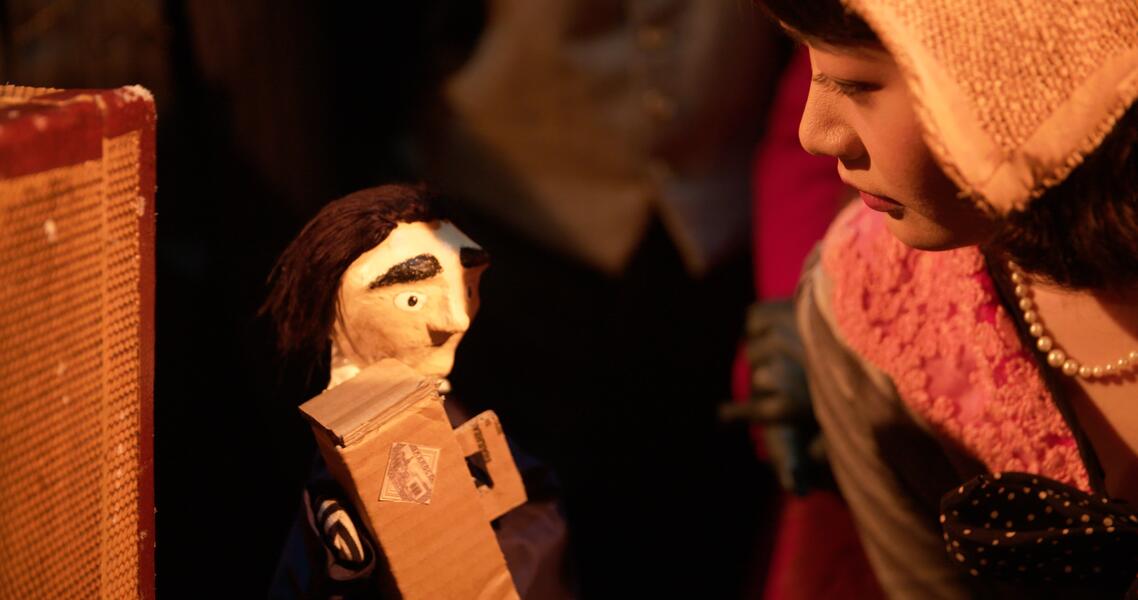 Puppetmeetswoman.jpghttps://vimeo.com/677788265 Pulling from a bounty of puppet footage, the trick was cull down to the most precise image.
Puppetmeetswoman.jpghttps://vimeo.com/677788265 Pulling from a bounty of puppet footage, the trick was cull down to the most precise image. -
Postcard, an Opera written at Peabody in 1920This is the entire 90 minute film done in the middle of Covid. The artist had to perform before an empty house. Five cameras were used to capture this opera that included puppets made by the school's designers.
-
Postcard from Morocco Sizzle 2.3.movThis is a trailer of Postcard from Morocco.
-
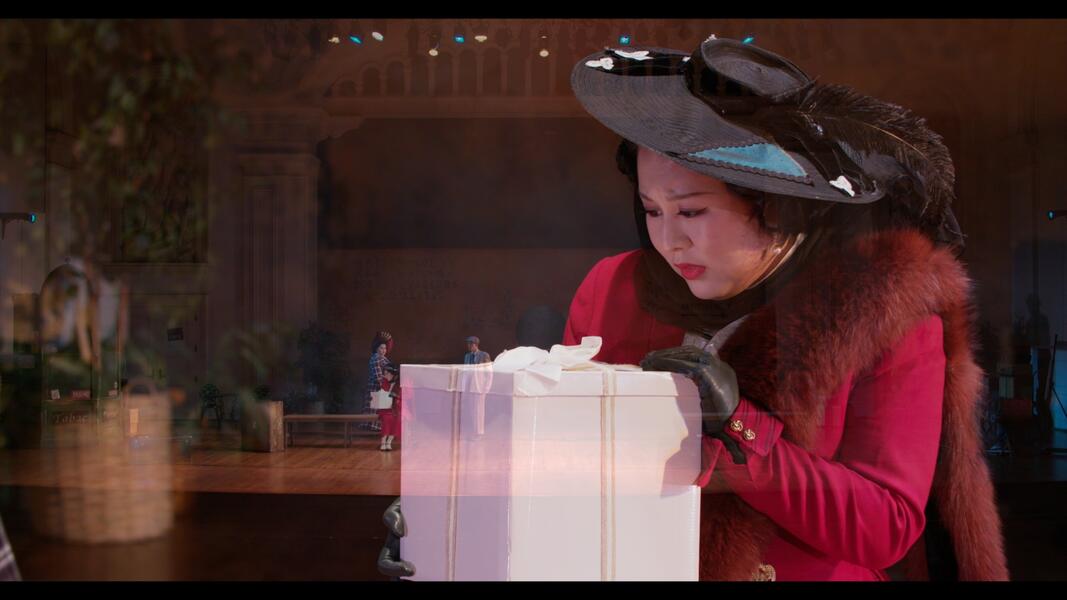 boxladyedit.jpgMaking cuts from the wide shoe to the Medium shots, timed with the score and the emphasis of the narrative
boxladyedit.jpgMaking cuts from the wide shoe to the Medium shots, timed with the score and the emphasis of the narrative -
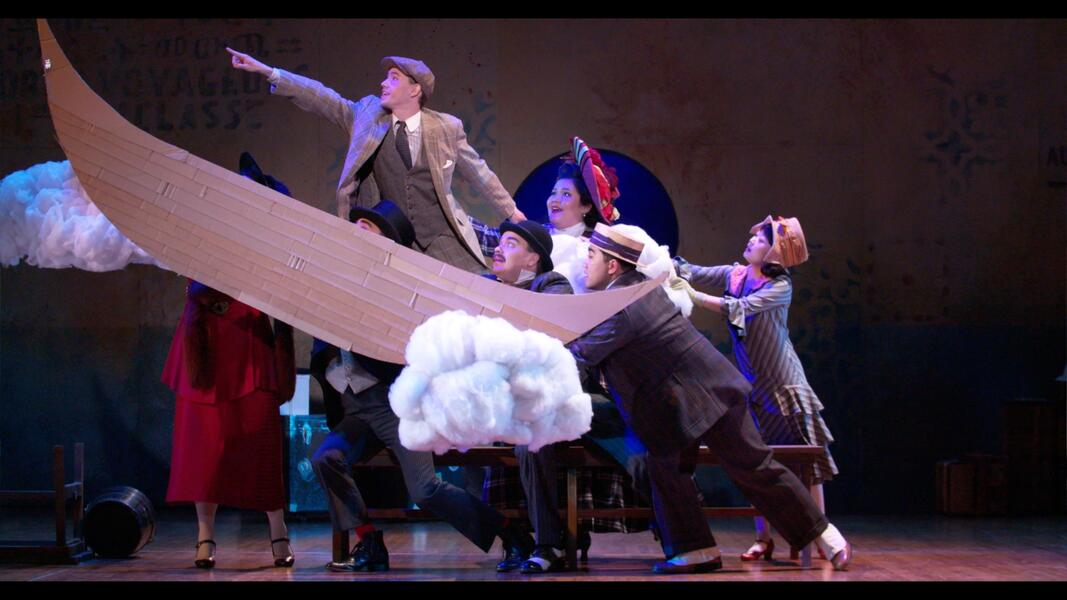 vikingship.jpgThe Finale. All props were carried by the actors and worked into the choreography.
vikingship.jpgThe Finale. All props were carried by the actors and worked into the choreography. -
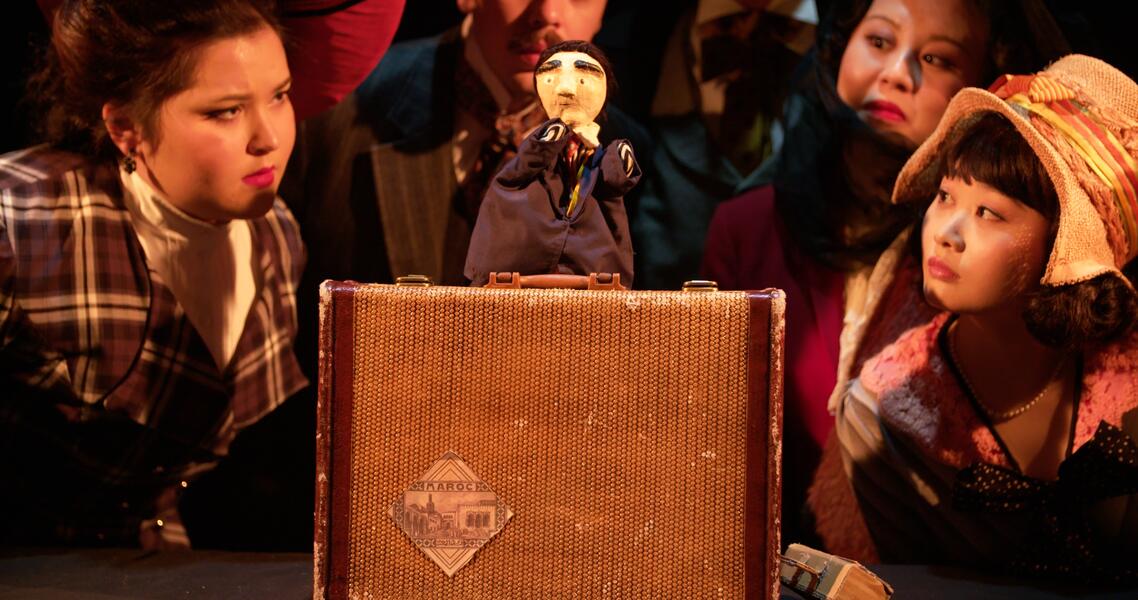 Puppetsuitcase.jpgThe interaction between the actors and the puppets (their replicas) were key moments in the opera.
Puppetsuitcase.jpgThe interaction between the actors and the puppets (their replicas) were key moments in the opera. -
Puppets Showcase
-
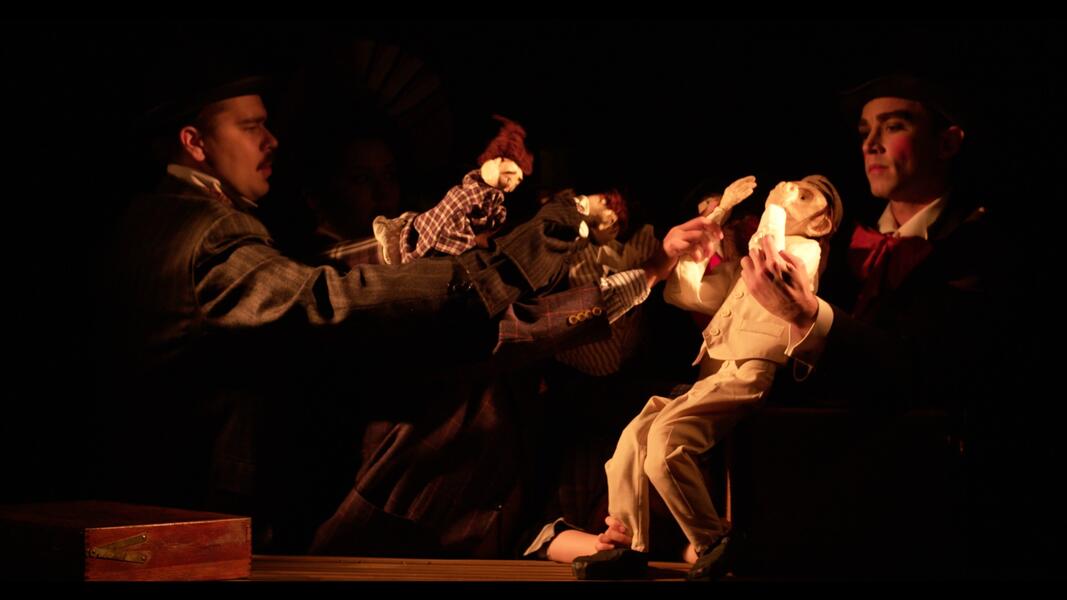 Puppet.jpgPuppets take over the narrative.
Puppet.jpgPuppets take over the narrative.
The Sonia Eaddy Playbook, When Winning is Not Enough
This film in progress, Sonia Eaddy’s Playbook, When Winning is Not Enough, follows the long-time resident’s 18- year- battle to preserve her block from a massive redevelopment aiming to turn the rowhouse neighborhood of Poppleton, in West Baltimore into block and blocks of multi-tiered, multi-use developments. By following Eaddy, her family and her diverse organization Poppleton Now as they use legacy media, street activism and social apps like Instagram to save her block of historic Post Civil War homes, our project capture a moment, a movement in the making. What started out as a speach during a Save Our Block barbecue has grown into a movement to stop the use of eminent domain as a developer's tool to clear out African American neighborhoods to make room for revitalization. Last July Eaddy's saved her house and block announced to the world through a mayor's press conference. But Eaddy and a group of activist our calling out the government driven developments as inherriently racist, creating segregation and instead are calling for community driven projects. Recognizing the importance and the success that is unfolding, I've been filming like a reporter assigned to a beat, believing funding and opportunity will follow. Granted access, I've also creted shorter edits that have been used in local pop-u[ film festival focusing on Baltimore gentrification issues.
-
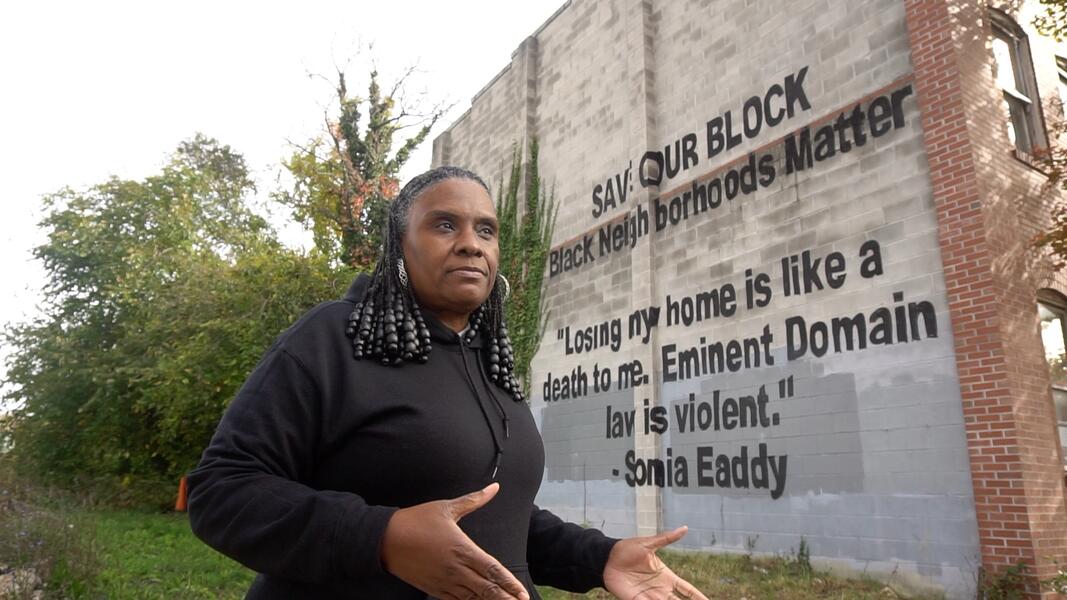 Sonia before Mural.jpgSonia Eaddy stands before a mural painted on the side of her house as she challenged the city's commitment to Black Neighborhoods and History. https://vimeo.com/746741175
Sonia before Mural.jpgSonia Eaddy stands before a mural painted on the side of her house as she challenged the city's commitment to Black Neighborhoods and History. https://vimeo.com/746741175 -
Bring Back the Brick
This is a project that was taken to my workshop, Profiles in Activism. This also represents my process of sticking with the narrative by finding outlets for my filming. As the story is always evolving, it is vital that I continue to create renditions, processing the context and the additions of new considerations.
-
A plea to spare the Saratoga Houses
This was made as short point of view, call to action video. But it also serves as a editing and shooting style that I want to employ in the final cut of the documentary The Sonia Eaddy Playbook, When Winning is Not Enough. I am aiming for this feel of being out in their lives in this case being with Porche and her daughter Trinity in the grass and exporing their family home now condemned. My goal is to get away from the talking head approach as much as possible.
-
https://vimeo.com/575536759This is an edit based on Sonia Eaddy's speech at The Save Our Block party. Her words sums of the conflict and the challenge when neighborhoods face eminent domain.
-
When Winning is Not Enough (A Sizzle Purpose Reel)This is a reel to reflect the depth of reporting, and nuanced storytelling as well as the end goals of this film/media project
-
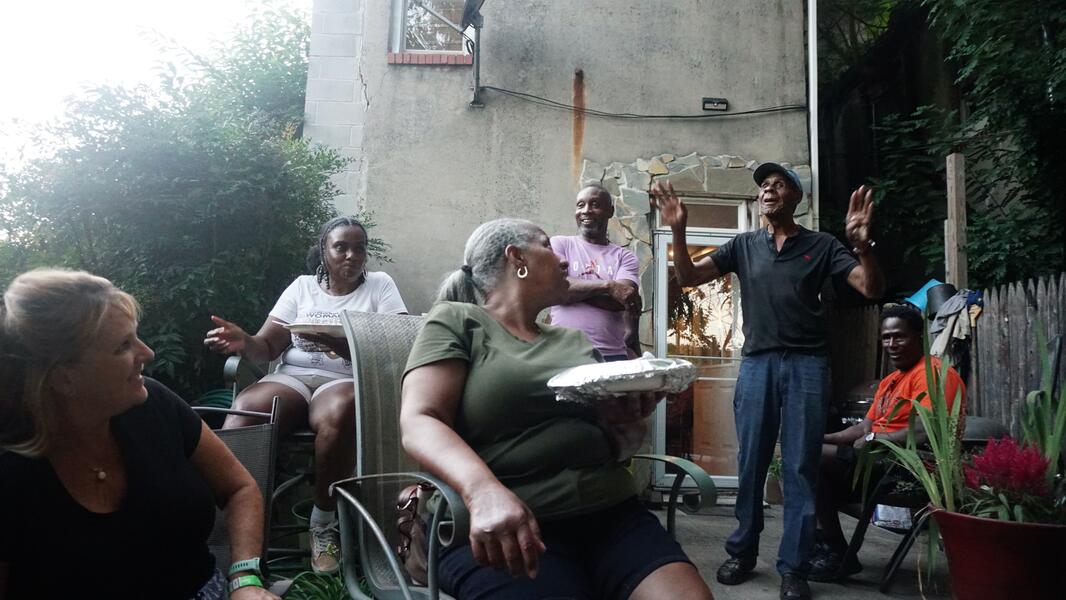 Donald(China).jpgDonald "China" Sonia's father, an esteemed A-rabber, Baltimore's Horse and Fruit cart peddlers, always has a story to tell. Here he is at Organize Poppleton's backyard cookouts/meeting. I have been given amazing access to this family and how they are responding to the developer's and the City's intent on remaking their neighborhood. Sonia and Organize Poppleton as well as Poppleton Now are determined to be part of the decision making.
Donald(China).jpgDonald "China" Sonia's father, an esteemed A-rabber, Baltimore's Horse and Fruit cart peddlers, always has a story to tell. Here he is at Organize Poppleton's backyard cookouts/meeting. I have been given amazing access to this family and how they are responding to the developer's and the City's intent on remaking their neighborhood. Sonia and Organize Poppleton as well as Poppleton Now are determined to be part of the decision making. -
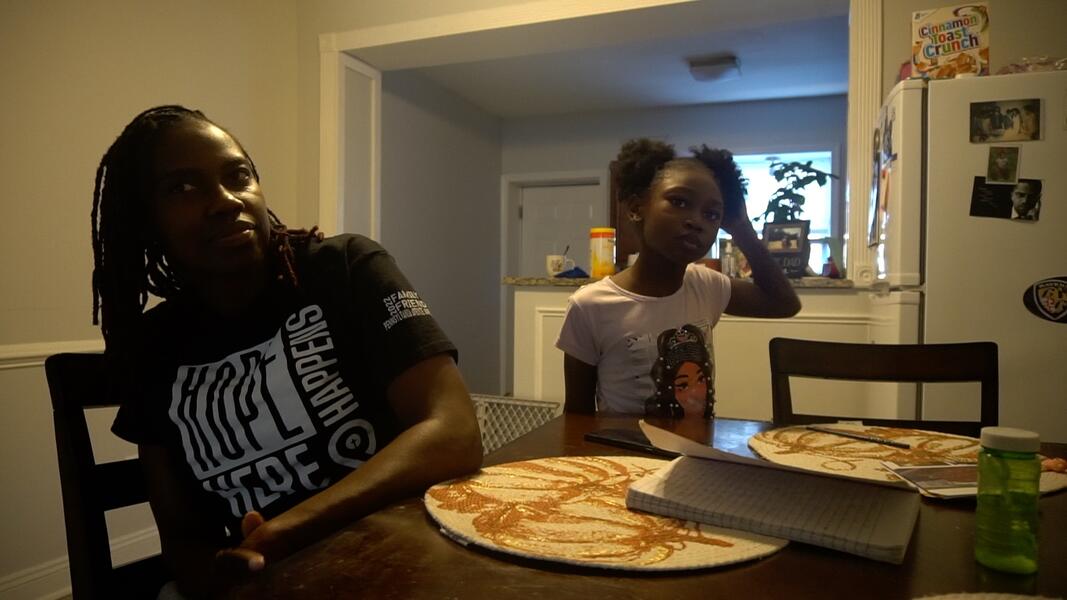 ParshaTrinity2.jpgParsha and her daughter Trinity in their new rented home. My interview style is really more conversational and although I may have set questions, I aim to have real moments take over. Trinity is a natural and she has a lot to say. While Sonia Eaddy is the main thread, I want to include other residents who didn't get their properties saved. There are stories behind all these vacant homes standing ready for demolition.
ParshaTrinity2.jpgParsha and her daughter Trinity in their new rented home. My interview style is really more conversational and although I may have set questions, I aim to have real moments take over. Trinity is a natural and she has a lot to say. While Sonia Eaddy is the main thread, I want to include other residents who didn't get their properties saved. There are stories behind all these vacant homes standing ready for demolition. -
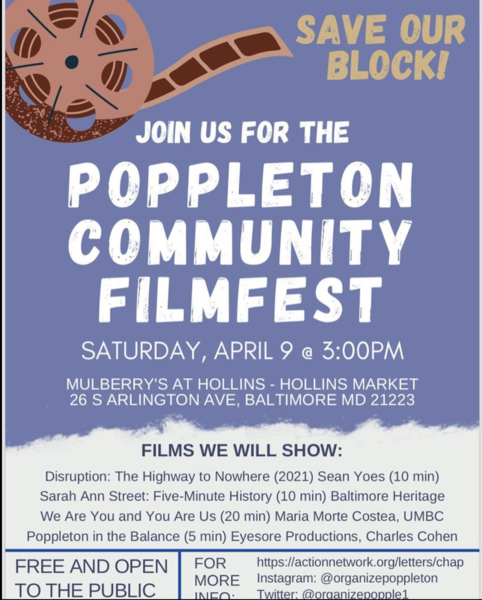 Screen Shot 2023-01-09 at 11.00.32 PM.png
Screen Shot 2023-01-09 at 11.00.32 PM.png
The Artistic Process of Others
I've been documenting and following the artistic process of three artists, Graffiti Artist Adam Stab, found nature artists Jordan and Musician Glenn Mumeau. The idea was to have them do and not tell. In the past I would perhaps follow their process and then circle around and do a deeper dive into their approach, doing an interview to get descriptions. While attaining description of process is effective and even necessary for certain purposes, these artists perfered to not really delve into their explanations. The energy was in what they were doing. With each of these projects there was a choice to allow the real time to take root or to agument action with expository. I opted for art as action. This voyoristic approach also has also re-enforced my own take on storytelling and being more cognenent of being in the moment of the process
-
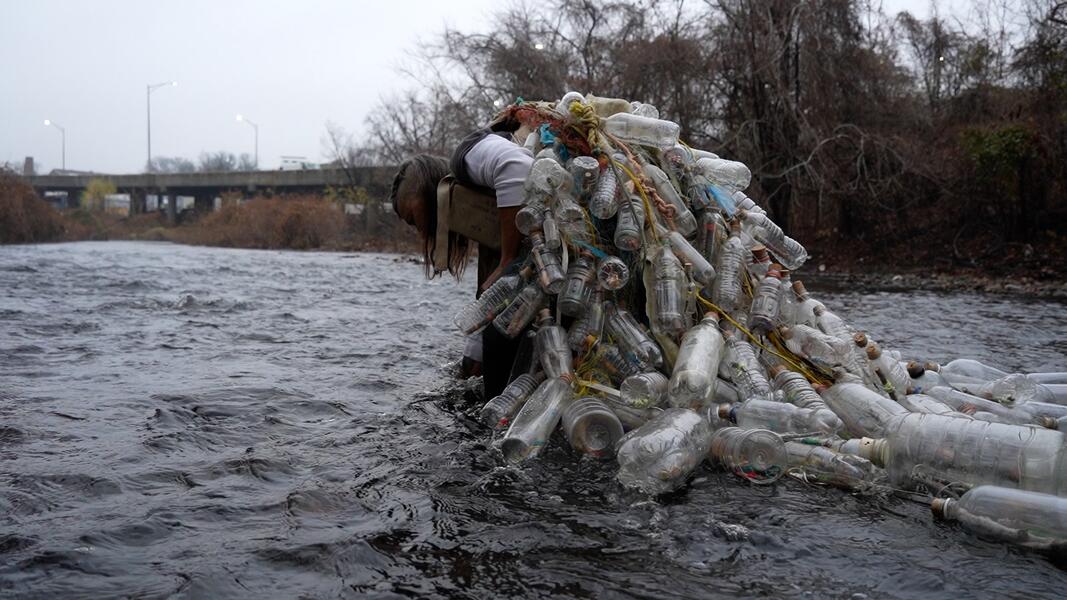 Profile bottlejacket.jpgJordan Tierney, a scavenger artists, created this bottle coat as a sign of the not to distant environmentally dystopian times. I followed wading into the Jones Falls, an unplanned move only part, and found out what she meant by her approach, “looking for everything and nothing, because then you’re open to surprises."
Profile bottlejacket.jpgJordan Tierney, a scavenger artists, created this bottle coat as a sign of the not to distant environmentally dystopian times. I followed wading into the Jones Falls, an unplanned move only part, and found out what she meant by her approach, “looking for everything and nothing, because then you’re open to surprises." -
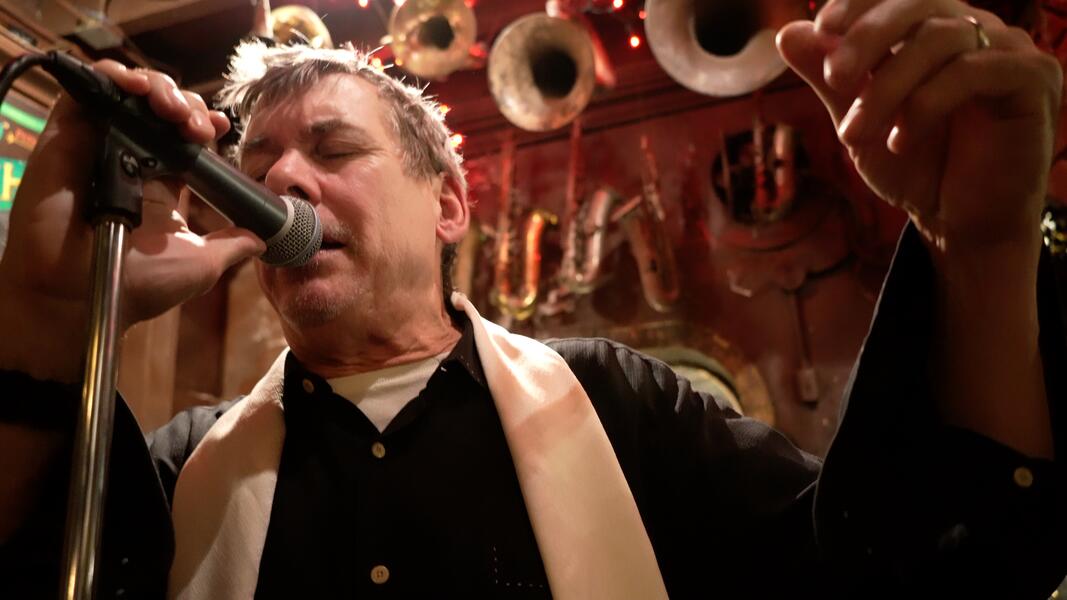 Glenn.jpgGlenn Moomau had created an unofficial residency at Bertha's, a Fells Point iconic bar, for nearly 20 years. After a three year Covid hiatus, he returned with his band for what might be the last time at this bar, which is due to be sold off. My objective wasn't just to capture the performance but also the atmospher where all patrons felt like they were down in a hold of a ship bent on a ruckus
Glenn.jpgGlenn Moomau had created an unofficial residency at Bertha's, a Fells Point iconic bar, for nearly 20 years. After a three year Covid hiatus, he returned with his band for what might be the last time at this bar, which is due to be sold off. My objective wasn't just to capture the performance but also the atmospher where all patrons felt like they were down in a hold of a ship bent on a ruckus -
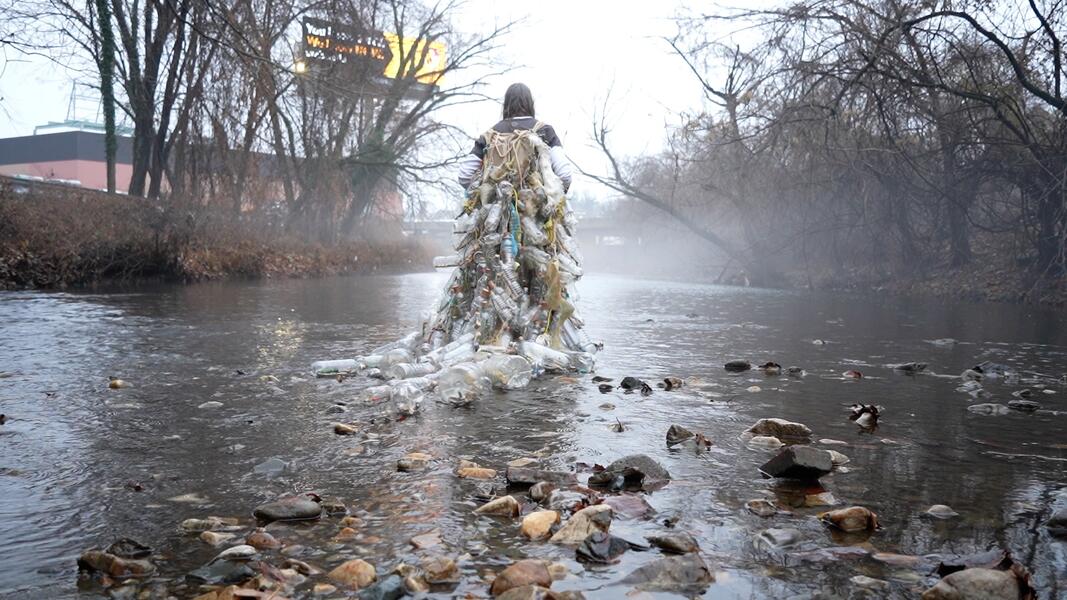 rocks.jpgJordan constructs art taken from her daily walk through Baltimore's urban wilderness. She sees city nature as both beautiful, resilient and frankly telling of a grim fate awaiting us if humans don't get a handle on pollution. Known as the Bottlecoat, Jordan envisioned a human creature fused from trash who thrives in the water of featuring refuse.
rocks.jpgJordan constructs art taken from her daily walk through Baltimore's urban wilderness. She sees city nature as both beautiful, resilient and frankly telling of a grim fate awaiting us if humans don't get a handle on pollution. Known as the Bottlecoat, Jordan envisioned a human creature fused from trash who thrives in the water of featuring refuse. -
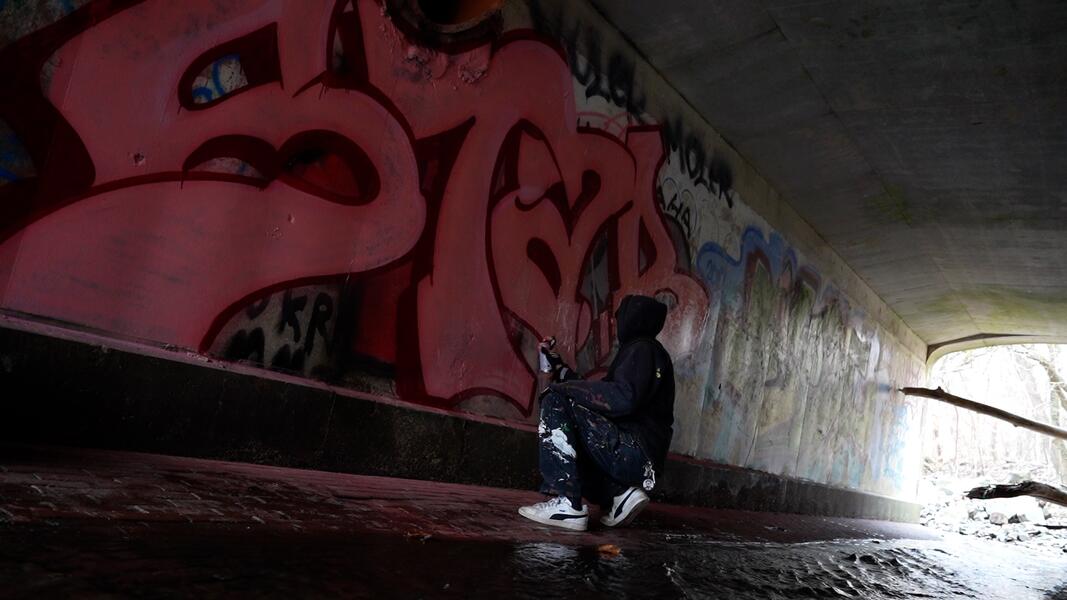 Stab3.jpgAdam Stab is what can be called a veteran Baltimore Graffiti artist, who approaches his surfaces with all design and placement in mind and how that makes or does not make a statement. Here he did a piece in a covert in The Western Run blocks from his mentor's childhood home, Clarence "Cuba" Robb, considered one of the founders of the Baltimore graffiti scene in the 70s and 80s, who died this year.
Stab3.jpgAdam Stab is what can be called a veteran Baltimore Graffiti artist, who approaches his surfaces with all design and placement in mind and how that makes or does not make a statement. Here he did a piece in a covert in The Western Run blocks from his mentor's childhood home, Clarence "Cuba" Robb, considered one of the founders of the Baltimore graffiti scene in the 70s and 80s, who died this year. -
2 minute reel All Aquatic .mov
This was Jordan's first launch of her bottle coat, wearing it as she waded through the Jones Falls. This was shot in a verite style with no re-takes, just allowing the experience to unfold in real time.
-
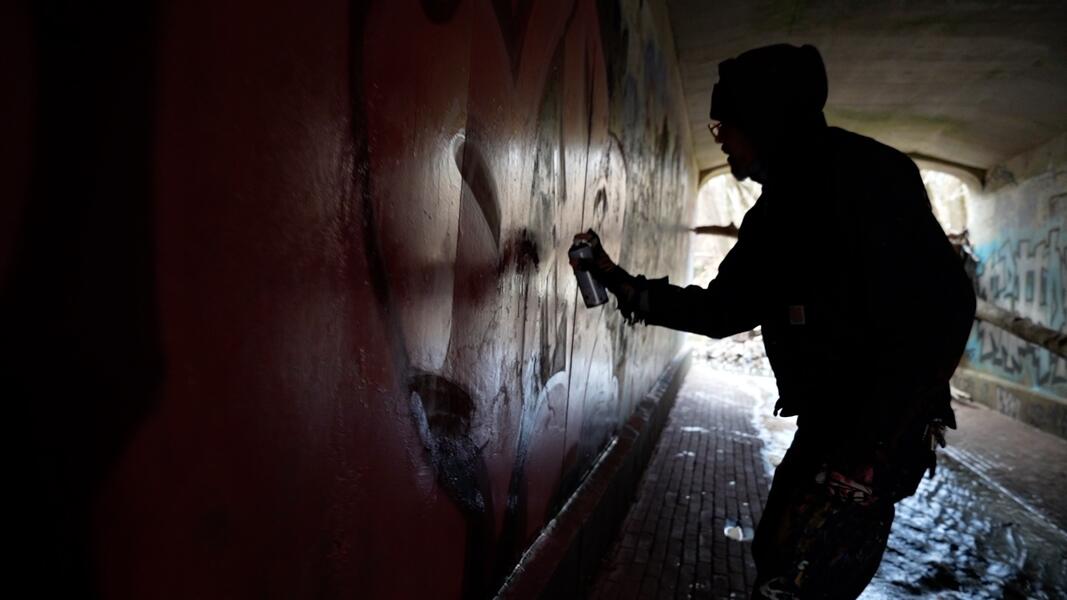 wallgleam.jpgI am drawn to the movement and output of graffiti artists. I have shot Adam several times and there's always a sense of drama of what is going to come next, how is it going to come next even though you know in the end it's going to be the word STAB
wallgleam.jpgI am drawn to the movement and output of graffiti artists. I have shot Adam several times and there's always a sense of drama of what is going to come next, how is it going to come next even though you know in the end it's going to be the word STAB -
Western Run Tunnel.movAny debate whether graffiti is an art form is put to rest when you watch Adam apply the letters. They don't just go up as script but in sense of form, starting out as lines, applied with a gripped spray can flinging windshield wiper motion. And then comes the fills and more lines to create depth. Shape is constantly moving, texture evolving.
-
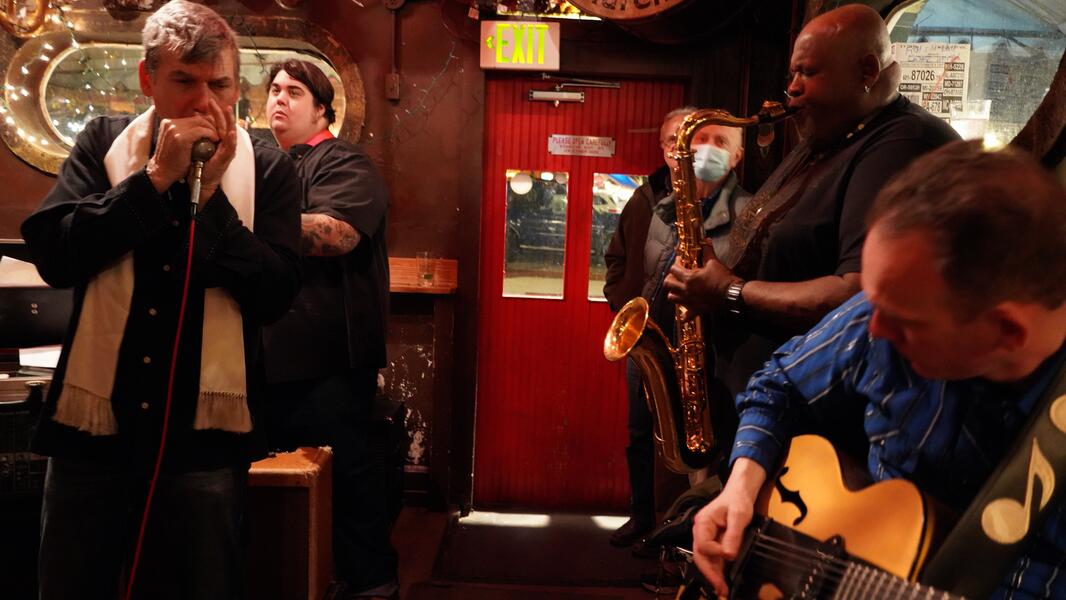 thebandjpg.jpgSticking to the verite approach, I shot Glenn Moomau and the Juke Drivers on what was reportedly to be the last weekend for Bertha's, Baltimore rather famous tavern that has been anchoring Fells Point since the 70s. Glenn and his band had a standing Friday night gig for more than 15 years. This was their first and performance since before Covid. I filmed this like a long take, knowing there was no central PA system and anticipating how the band members would play off each other.
thebandjpg.jpgSticking to the verite approach, I shot Glenn Moomau and the Juke Drivers on what was reportedly to be the last weekend for Bertha's, Baltimore rather famous tavern that has been anchoring Fells Point since the 70s. Glenn and his band had a standing Friday night gig for more than 15 years. This was their first and performance since before Covid. I filmed this like a long take, knowing there was no central PA system and anticipating how the band members would play off each other. -
TheJukeDrivers.movMy goal was to capture the distinct feeling of playing live at Bertha's where the band is crammed next to the door in a corner, where patrons funnel in and out and the music must play on. This whole set up was pretty standard back in the 70s and earlier but today's modern venue would ensure much more space. This camped we're all on the same ship together mates was essential to Bertha's love-ability.
Riding Wild, A So Called Documentary
Funded by the Saul Zaentz Foundation, this documentary allowed me to concentrate on the use of music to propell and shape the story. All the music was original, created by Jason Gray with me serving as producer. The power of music cannot be over-stated and is something I will be exploring in the near future.
-
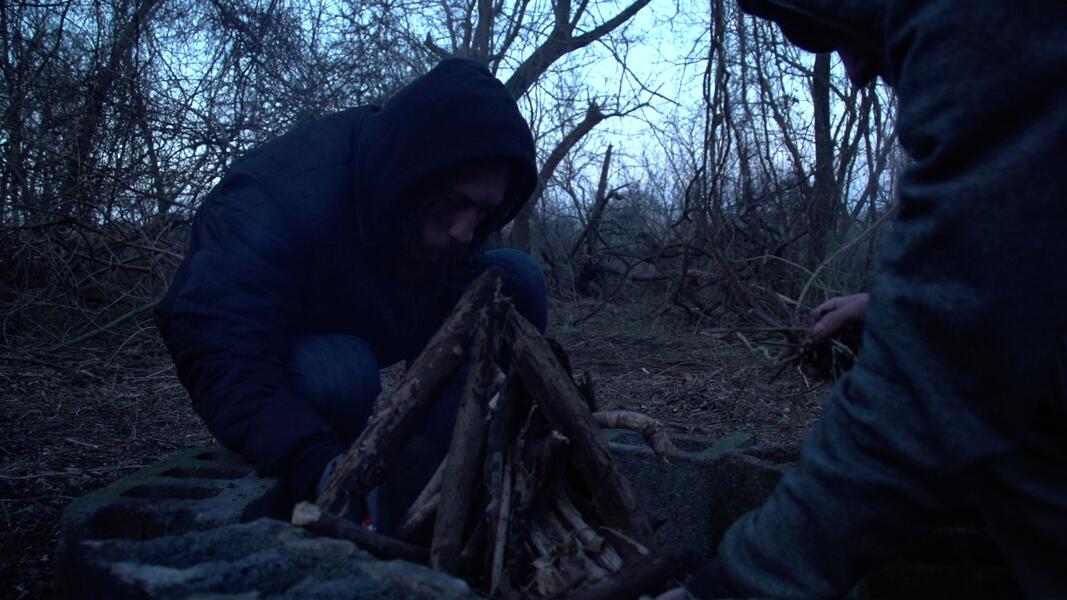 Fire neededThis crew is determined create a place for themselves in this city dumping ground. Their passion is demonstrated by the constant manicuring of the dirt tracks to their ability to find salvation in this urban wilderness.
Fire neededThis crew is determined create a place for themselves in this city dumping ground. Their passion is demonstrated by the constant manicuring of the dirt tracks to their ability to find salvation in this urban wilderness. -
Riding Wild: Documentary TrailerRiding Wild follows Dink as he leads a crew of BMXers to bushwhack an illegal set of trails along a raggedy patch of urban wilderness to escape their violent neighborhood in Baltimore. Funded by the Saul Zaentz Innovation Fund and completed in December 2017, Riding Wild was shot like a road movie considering the subjects are always in motion. However, this is a road movie that never leaves home, that is; all that wanderlust and sense of discovery must take place within the confines of the city rather than through the inspiration of unchartered territory. This immersion approach is a major theme for me in my work. Riding Wild played in festivals across the country and won the Jury Award at the Montana International Film Festival
-
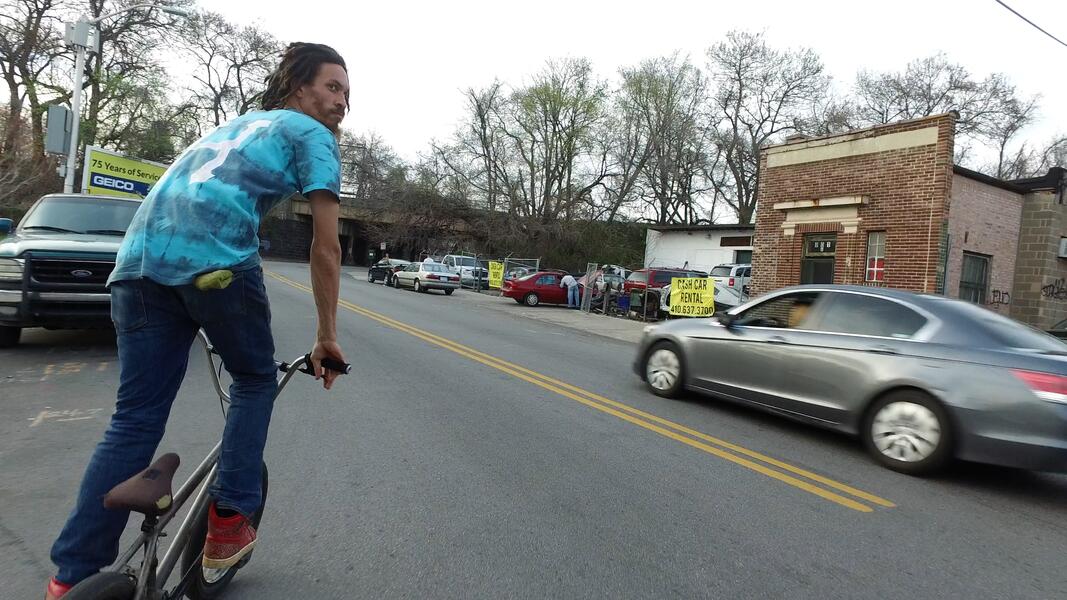 Shoot on WheelsMuch of our shooting was done with small cameras called Osmos, which sat on balancing systems. This project allowed me to explore collaboration with the subjects. Dink, the main subject, shot this of his friend Ian Burke. Dink proved to have a strong eye and a knack for getting shots, better than me when on a bike that's for sure.
Shoot on WheelsMuch of our shooting was done with small cameras called Osmos, which sat on balancing systems. This project allowed me to explore collaboration with the subjects. Dink, the main subject, shot this of his friend Ian Burke. Dink proved to have a strong eye and a knack for getting shots, better than me when on a bike that's for sure. -
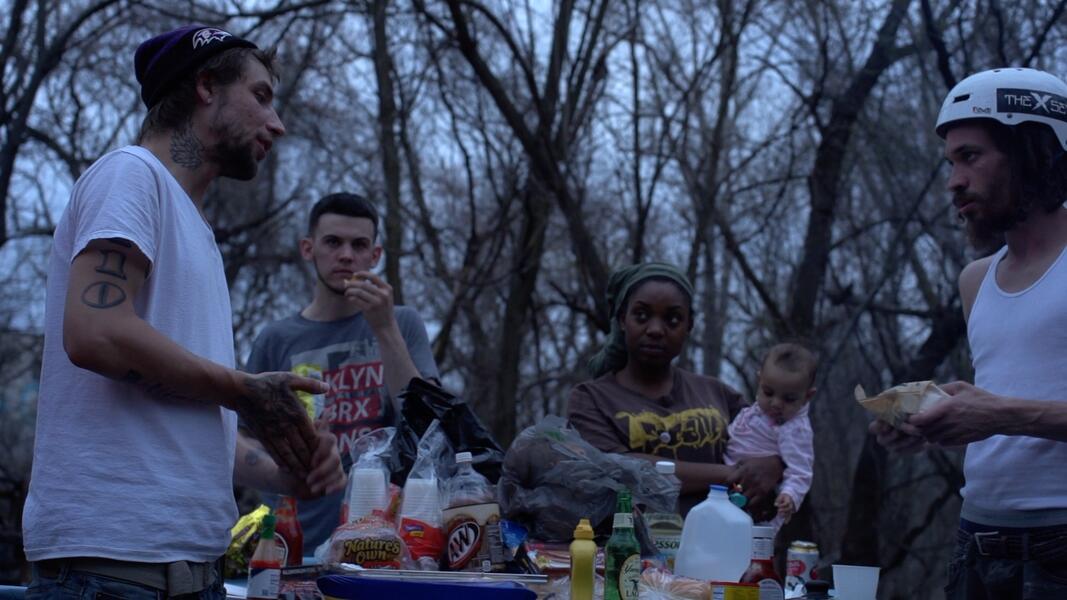 Trail LifeWe opted to film as they lived even if it meant not getting the standard three point lighting interviews -- Thus the subtitle, “A so-called documentary.” As a result, Riding Wild offers a different view where urban woes don’t follow a problem-solution narrative that seems to be a prerequitive for any social docs. Rather our prime direction was reveal what was it like to be with them. As a result Riding Wild shows them in a perpetual state of aspiration, like any person riding on the fumes of creativity, which in their case lives on the road, on the trail, always in motion. So long as they are moving, their pre-asssigned status has no hold. As Jack Keroack put it there is “nowhere to go but everywhere.”
Trail LifeWe opted to film as they lived even if it meant not getting the standard three point lighting interviews -- Thus the subtitle, “A so-called documentary.” As a result, Riding Wild offers a different view where urban woes don’t follow a problem-solution narrative that seems to be a prerequitive for any social docs. Rather our prime direction was reveal what was it like to be with them. As a result Riding Wild shows them in a perpetual state of aspiration, like any person riding on the fumes of creativity, which in their case lives on the road, on the trail, always in motion. So long as they are moving, their pre-asssigned status has no hold. As Jack Keroack put it there is “nowhere to go but everywhere.” -
https://vimeo.com/373226938This is the entire film. This was done in a verite style in that I wanted to share the experience of the ride along or what journalist called embedding with, as creating a narrative, which in a way is contrived and applied to boilerplates. There is nothing wrong with the narrative complete with conflicts and challenges and darkest day before the dawn moments, but it is a contrivance that we as viewers come to demand. During the two years I followed Dink and his So-Called Crew didn't provide that package and rather force that arc I embraced the strength of the film and aimed to share the true attraction which was the experience in of itself. .
-
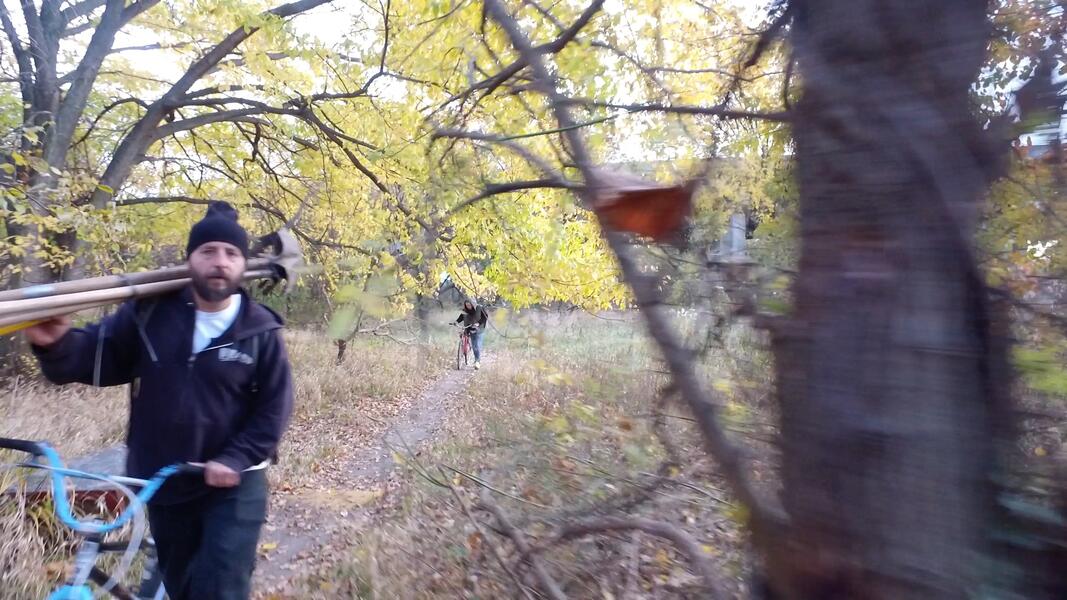 Dink and his shovelsRiding Wild was a subversive nature doc showing how people get the most out of their surroundings and with this perspective, the beauty was revealed. I allowed the film to breath in these parts. I collaborated with Musician J Gray, who made an original score for these moments where the environment emerged as the major point.
Dink and his shovelsRiding Wild was a subversive nature doc showing how people get the most out of their surroundings and with this perspective, the beauty was revealed. I allowed the film to breath in these parts. I collaborated with Musician J Gray, who made an original score for these moments where the environment emerged as the major point. -
Riding or Punch in the FaceIn this documentary I worked with composure Jay Gray to create eight pieces to emphasize points or capture the rhythm that was present during the shooting from always being on the move. I embrace music in documentary filmmaking and believe the right use of a tune can transform a scene. Here's one example. https://vimeo.com/248250156 Password music
-
Promo https://vimeo.com/243014288This is the trailer https://vimeo.com/243014288 Riding Wild, a two year ride along with a crew of BMXers who make trails in some city woods to keep away from the violence. This is the example of the instagram campaign I'm employing to support the documentary. https://www.instagram.com/ridingwilddoc/
The Last Horsewoman of Baltimore,
For five years I have been filming Dorothy and her husband David tending their horses at The Bruce Street Stables in West Baltimore in one of the more tougher neighborhoods in the city. Dorothy and John are part of a Smithsonian-recognized folk tradition known as the Baltimore Arabbers, Dorothy not only owns one of the three remaining stables in the city, but is the grand daughter of the first African American female stable owner, Margaret Allen, who oversaw several wagons.
Arabbing has long been a lure for storytellers and visual artists alike. And for good reason. The Arabbers, a term hailed from a 19th Century English description to denote street urchins, have been repurposed here in Baltimore for a group known for their colorful wagons laddened with fruits and vegetables, their bell-harnessed horses and their howlers. Together, the Arabbers are a welcomed sight on streets be they in rich neighborhoods or streets that don't even have corner stores.
For me I wanted to go deeper than their folklife ways into their day and life routine of going through a modern city with a horse. Through cinima verite I want to exlpore the idea of how despite the horse and wagon being the antithis of modern life, their presence offers a balm to the deterioration of city life, a sense of history as well as a surprising practicality to bringing fresh fruit and vegetables door to door, a concept that has been re-invented by apps and nimble companies like Door Dash. Arabbing is a tough living and the verdict is out whether young people want to literally pick up the reigns. But Dorothy still sees the tranformative force of horses and is on a mission to create an equestrian center for young people. She has a foothold in a block where homes just got plowed under, making an ideal urban pasture -- a kind of Living Classroom with horses.
For the past few years I have watched Dorothy and John work the mundane chores of turning over the hay, fixing the wagons towards their dream of creating a learning center in the city. Then last year, the endeavor was threatened by a robust tree growing out of the back of the stable wall. Fortunately she was able to secure funding, a turning point I was able to capture and contexualize in a film called Verite Reportage. The advantage/fortune of taking time to hang out with a camera is to slowly amass the little things, the golden flecks of moments that normally don't make it in story archs. For me it's these moments that carry the deepest meaning, such as the horse walking by the wrecked homes to the pasture, the sirens wailing, a story about hustling cookies or the simple act of slapping rediculously brilliant red paint on the wagon. These little things I let speak for themselves in a twenty minute video, a culmulation of several years of shooting.
Then there is the seven minute video, a result of one lucky afternoon of shooting at another stable that sums up the constant refraim from old timers of how as kids they got what is known as "horse crazy." This video features an uncle and his four year old niece who obviously loves every minute from caring for the hooves to shoveling manure. Again, I want the series of images to speak loudest in a verite style.
I have included other edits to demonstrates a repurposing process where I have reduced longer piece to small cuts or changing the voice from narrartion to testimonials. Edits of course change with the purpose, some were calloborations with students from an onsite class at the stables that I organized with Hopkins. As I continue to shoot I will always be reworking an approach, searching for better ways to tell this unique story of not just seeing Baltimore via horse and cart but a larger humanistic tale of struggle for purpose, solution and yes to embrace life's hidden pagentry.
-
Arabber VeriteWe follow how Dorothy and John's routine of tending their horses in the city gets threatened when a robust tree growing out of the back of a stable threatens the entire operation.
-
The Baltimore A-rabbers, Their exodus within a City
In 2008 I started filming the plight of a group of A-rabbers, who were evicted from a stable and then were moved by the city to a parking lot at Pimlico Race Track and then to under a bridge in West Baltimore. From that story emerged Dorothy Johns, who went from owning two horses to owning a stable and represents the best hope for this unique Baltimore tradition's survival.
-
Horse Crazy
Baltimore horse-people known as Arabbers, say their love for the equestrian life is due to being "horse crazy" at a very young age. We witness this phenomenon right before our eyes. This film while raw also reflects my stripped down approach, usually traveling with mics, camera, but no lights and definitely no boom pole. I believe the lighter you enter a story the more real and the deeper you can go.
-
Arabber Sizzle ReelThe reel reveals the themes and approaches to the on-going project of following Stable Owner Dorothy Johns' struggle to keep A-rabbing viable as a trade, a tradition and an opportunity for community outreach in Baltimore
-
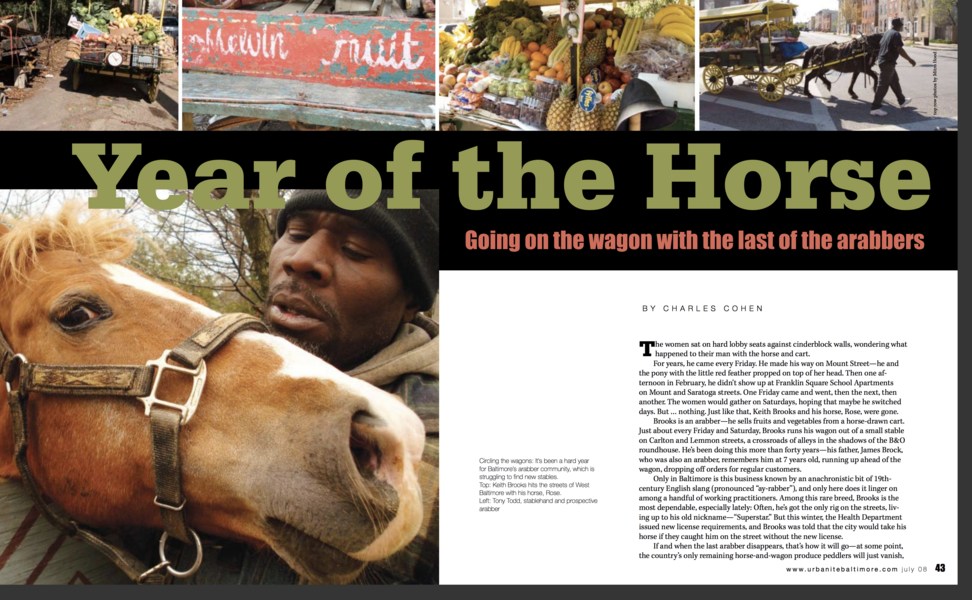 Publications.
Publications.This is from the feature story I wrote for the now defunct magazine The Urbanite. I took the photo of the man with the horse. I also provided a video series covering the eviction of the Arabbers from a large stable near North Avenue. Below is the article I wrote for the New York Time in 1995 and I have documenting the Arabbers ever since. For Horse-Drawn Carts, Hurdles in Baltimore By The New York Times Published: November 12, 1995 (Being a stringer, I didn't get a biline.) • BALTIMORE, Nov. 11— Boom Boom knows how to make his horse cart look like a gourmet produce market on wheels. And he, his grandfather, fiancee and son have more than a century of knowledge among them in the Baltimore peddling tradition known as arabbing. Loading from a sidewalk, Boom Boom, whose given name is James Chase, packs a bounty of cantaloupes, tomatoes, collard greens, sweet potatoes and tangerines. He crowns the spread with bunches of grapes, which he'll pluck and eat as he plods his way through some of the toughest streets in Baltimore. But these days being an arabber (pronounced AY-rab-ber) isn't just a matter of creating a splashy cart to compete with the supermarkets and convenience stores. The arabbers find themselves trying to weather urban development and some stormy politics. The neighborhood where some arabbers stable their horses, Sandtown-Winchester, is undergoing a major development project that will include block after block of new town houses. In addition, in the last two years an animal rights group, the Maryland Horse Protection Coalition, has tried to shut the arabbers down, saying that the horses are mistreated. On the other side of the debate, some neighbors -- a carpenter, an artist and other residents -- have formed the Arabber Preservation Society, which has taken on the city bureaucracy and has helped rebuild one of the stables. The debates are a stark contrast with the low-key life of arabbers, who spend their days walking beside the carts through the city's neighborhoods, calling out a litany of their wares. They are known simply as Fat Back, Cabbage, Popeye and just plain Fruit, rarely revealing their given names. Most of their horses were bought from auctions where they would otherwise have been sold to slaughterhouses. Now the horses clip-clop their way through their second life under the names Overdose, Tumble-Weed and Snake Eyes. The arabbers, almost all of whom are black, live an old-fashioned life. Even their name has an antiquated echo in an ethnically sensitive era. The term arab comes from a 19th-century description of people who made their living on the streets, or of homeless children, according to Mary Makey of the City Life Museums. At the turn of the century, most of the arabbers were white. Some were simply farmers bringing their produce to town. The black peddlers covered the ground on foot, selling oysters and deviled crabs. But during World War II, the white arabbers abandoned their horses and carts. Today, about 25 arabbers are licensed by the city, said the Preservation Society's president, Steve Blake, who has a wagon, horse and peddler's license. Only about a dozen earn at least part of their living from hauling produce around town. The remainder are retired or "horse-crazy" and hang around the stables. Four stables clustered in West Baltimore are all that remain. The Whatcoat Street Stable from which Boom Boom works, which has been owned by Fat Back's family for 50 years, is slated to close in January to make way for the new housing development. From his cart, Boom Boom can see a shiny block of new town houses across the street, the kind seen in the suburbs. The city is considering a proposal to relocate the Whatcoat Street Stable to nearby historic Lafayette Market, but the arabbers who remain are more concerned about the animal rights forces. On Friday, the debate came to the stables themselves when Baltimore City Animal Control inspectors arrived to check the horses. Animal rights people carrying clipboards also tried to enter to check the animals for themselves. Welcoming them were Preservation Society members, who advised the stable owners of their rights -- particularly the right not to let anyone in who was not wearing an inspector's badge. The animal-control investigation supervisor, Bill Morris, made his rounds, checking hooves and temperatures and examining the stable roofs for leaks. When refused entry, the animal rights people milled around in the alley, peering into locked buildings. At one point, an older arabber yelled, "When white people owned the horses, you never saw them." Members of the Maryland Horse Coalition defended their presence at the inspections, and they credit their persistence with recent stepped-up city inspections. "If we back off, they're not going to do anything," said one coalition member, Colleen Brown. Another coalition member, Mark Rifkin, said, "The only thing we're willing to negotiate is when will they go out of business -- five years, four years?" The coalition's efforts to persuade the city to end arabbing or at least insure the welfare of the horses is backed by the Humane Society of the United States and People for the Ethical Treatment of Animals. Ms. Brown said that in March, a horse died in the street after escaping from its owner. The owner is being investigated by city officials. Mr. Morris, of animal control, would not elaborate on the details, but Ms. Brown provided a city Department of Health memo that said a witness had seen the owner riding and whipping the horse. The owner, according to the memo, denied whipping the horse and said he had been trying to stop it from bolting. In January 1994, two horses froze to death, and three others were taken to a farm from unlicensed stables that have since been shut down. Mr. Morris has heard this criticism before, but he rejects the coalition's stance that the horses do not belong in the city. "My question is, Why shouldn't they have the animals in the city?" he said. After reading the book, "The Arabbers of Baltimore" written by ex-arabber Roland Freeman, Mr. Morris said that he was convinced that the horse-powered peddling trade was part of Baltimore's indigenous culture. At 21, Mr. Chase knows his history. He's been "horse crazy" since he was old enough to walk. One Christmas, his grandfather gave him a pony. Next year, he and another arabber are planning to go to a blacksmithing school in Oklahoma on a grant obtained by the Preservation Society. On this cold November day, Mr. Chase is the last one to pull off with his horse Dirty White and his partner -- Twin, or 15-year-old Kevin Chesley -- in the bright sunlight that offers no warmth. He leaves behind his grandfather and the other old-timers to huddle around a barrel fire and tell stories from the Depression. "If you work two days, if you made a dollar, you made money," said Cabbage, wearing an Irish-style cap. Boom Boom and Twin are the new generation arabbers, a world away from when arabbers could be seen in every direction. Now when he turns the corner, he sees a long street in which the first block of lipstick-red row houses are deserted. But the street corners in the next block are jumping with people. Boom Boom and Twin navigate the scene to get to their steady customers. A gray-haired woman yells down from the second-floor window: "How much are your bananas?" A tow truck driver parks in the middle of the street to check over the wagon. Unlike the old-timers, Boom Boom never belts out the traditional arabbers' refrains. "They know when I'm coming," he said. During his rounds, Boom Boom waves at his mother and meets up with his fiancee, Shawnta Crampton. Last year, he left her with the cart and the next thing she knew, she was walking the horse down the street selling produce. Now she's vying with Boom Boom to take the cart out on the weekends. Later on, they'll meet their 5-year-old son, Binky, who will walk alongside them. "Yeah, he's into it," she said. "He says, 'Can I go with you and make some money?' "
-
Arabber Project with student crew and productionThis is from a class project where students from the community helped interview, shoot and edit this piece.
-
The love and hate of horses 2This is also a film made with two young people from the community. This one I am especially proud of since the two participants were extremely shy and it was Dorothy Johns, who stepped up and helped them shoot, sometimes she shot them herself. This was a first film for all three.
-
Fatback's FuneralThis was the funeral for Eugene "Fatback" Allen, whom I knew and admired. This was also the moment where his granddaughter Dorothy Johns felt a sense of urgency to not only archive a culture on the verge of extinction but reinvigorate it as a source of inspiration and belonging for a current generation growing up in a part of the city with increasing obstacles and demising opportunities.
-
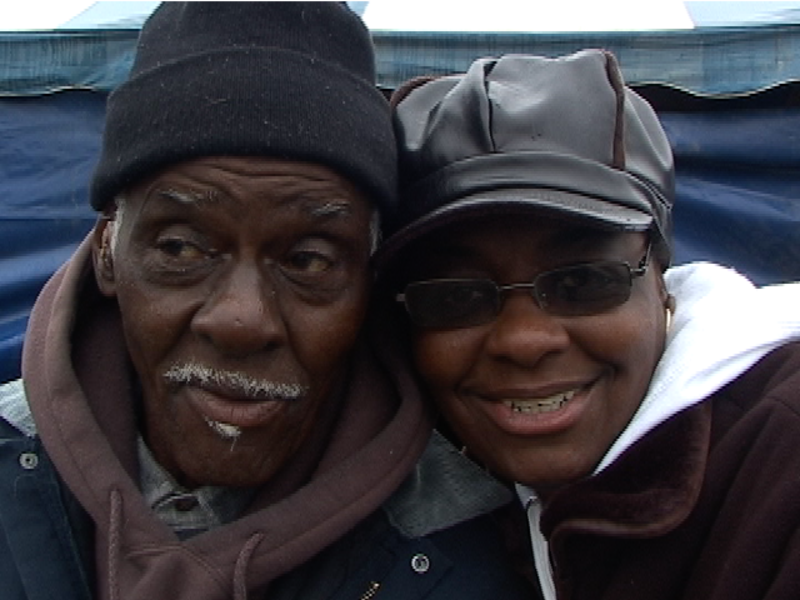 Fatback and Johns .pngThe late Eugene "Fatback" Allen with his Niece Dorothy Johns, who as a stable owner, is trying to keep the tradition going even if it means embracing reinvention.
Fatback and Johns .pngThe late Eugene "Fatback" Allen with his Niece Dorothy Johns, who as a stable owner, is trying to keep the tradition going even if it means embracing reinvention.
Delaware Bob, the Unknown Story of Bob Marley in Wilmington, Del.
-
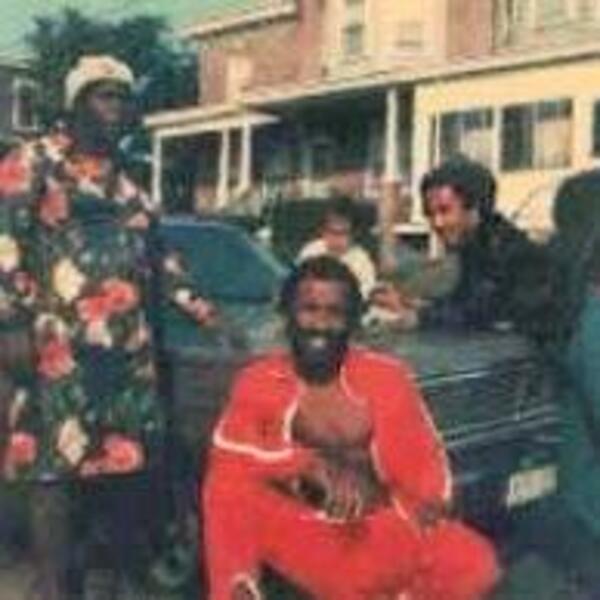 Ibis with Bob.jpgThe Late Ibis Pitts with Bob Marley in Wilmington, Del. Ibis went on to create the Bob Marley Festival (blessed by Marley's Mom "Mother Booker") in Wilmington in honor of his friend Bob. His wife Ginny and her sons and daughters now run the international festival.
Ibis with Bob.jpgThe Late Ibis Pitts with Bob Marley in Wilmington, Del. Ibis went on to create the Bob Marley Festival (blessed by Marley's Mom "Mother Booker") in Wilmington in honor of his friend Bob. His wife Ginny and her sons and daughters now run the international festival. -
Delaware Bob in the makingDelaware Bob for an exhibit at the People's Festival in Wilmington, Del. Password Exodus
-
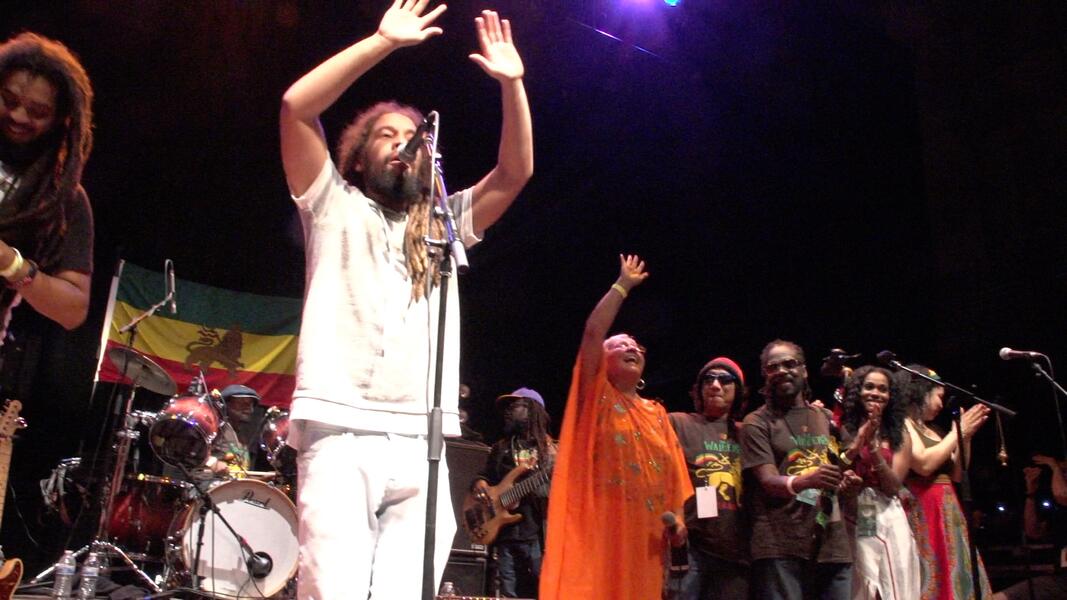 Ginny and the WailersGinny Pitts, picture in orange, stands with the Original Wailers for their return to Wilmington. Ginny along with her husband Ibis knew Bob Marley and his mom who lived in Wilmington. This is part of an ongoing documentary on Bob Marley's life in Wilmington and his legacy that lives in the community today.
Ginny and the WailersGinny Pitts, picture in orange, stands with the Original Wailers for their return to Wilmington. Ginny along with her husband Ibis knew Bob Marley and his mom who lived in Wilmington. This is part of an ongoing documentary on Bob Marley's life in Wilmington and his legacy that lives in the community today. -
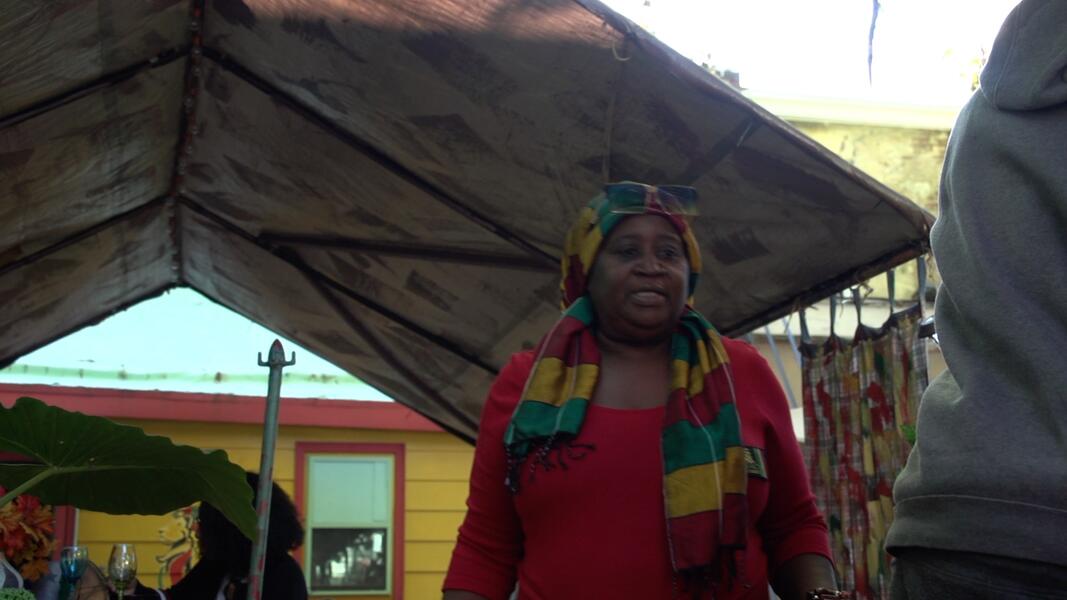 Elaine.jpgElaine owns the unofficial Bob Marley House off of One Love Park in Wilmington. She knew Marley and was suppose to be one of the backup singers but he died. Her entire house is painted and dedicated to the musician.
Elaine.jpgElaine owns the unofficial Bob Marley House off of One Love Park in Wilmington. She knew Marley and was suppose to be one of the backup singers but he died. Her entire house is painted and dedicated to the musician. -
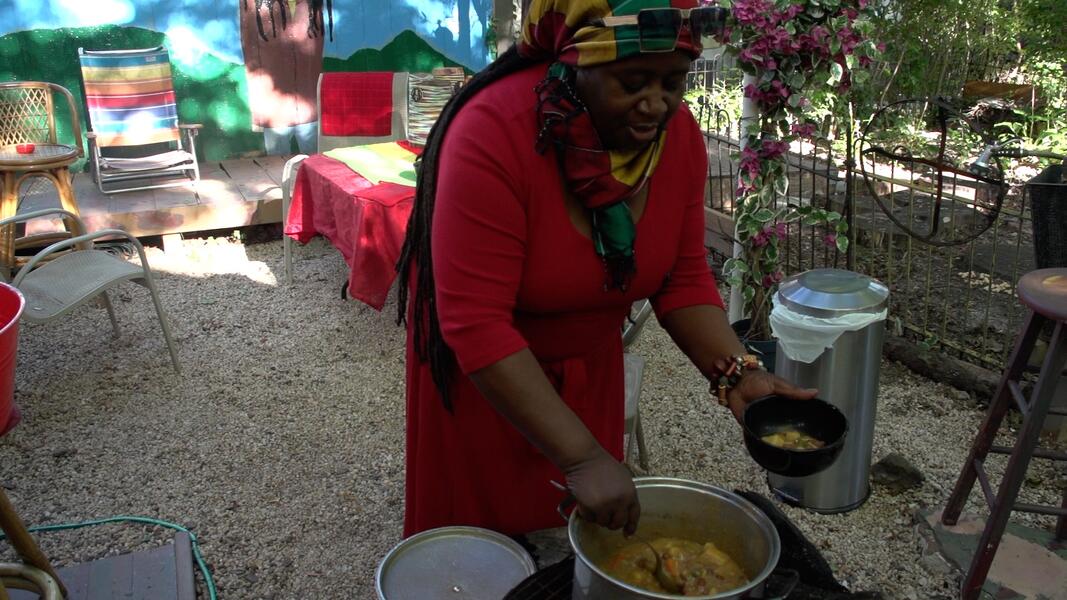 Elaine preparing stew.jpgElaine cooks in her "island backyard" making a tradition Jamaican vegetarian stew that was prepared for Marley when he visit Wilmington during his U.S. tours.
Elaine preparing stew.jpgElaine cooks in her "island backyard" making a tradition Jamaican vegetarian stew that was prepared for Marley when he visit Wilmington during his U.S. tours.
Documentary --- Fiddles and Football -- adding my own little spin on History.
The Last Season, The Life and Demolition of Memorial Stadium (2002), was my first documentary and remains a guiding light on what can be possible. This project was a team effort with filmmaker Joseph Mathew, whose follow up film Crossing Arizona was selected for Sundance. For two years we filmed the demolition, the last-ditch efforts to save the stadium and the ritualistic impromptu homages by people stopping by to pay their respects. In the process, we interviewed athletes from Cal Ripken Johnny Unitas to fans like Wild Bill Hagy. While the subject may be officially about the stadium the result was capturing a city at a cross-roads as it moves from collegial to being more professional. As one observer put it about Memorial Stadium, “This was our backyard.”
Both these films represent my obsession to press the pause button and swing the camera around to the areas that get little attention but still offer expansive windows into what makes this American culture tic.
-
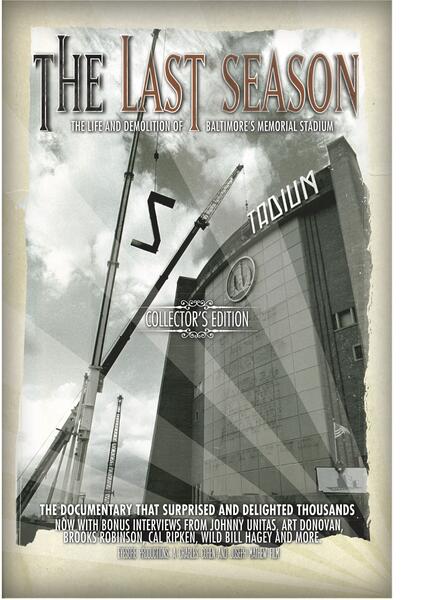 lastseason_poster.jpgThe Last Season was a top ten seller in the Baltimore metropolitan area, back when DVDs was actually something that you could sell. This was my entree into filmmaking world as still sits as an example of creating your own market for your work.
lastseason_poster.jpgThe Last Season was a top ten seller in the Baltimore metropolitan area, back when DVDs was actually something that you could sell. This was my entree into filmmaking world as still sits as an example of creating your own market for your work. -
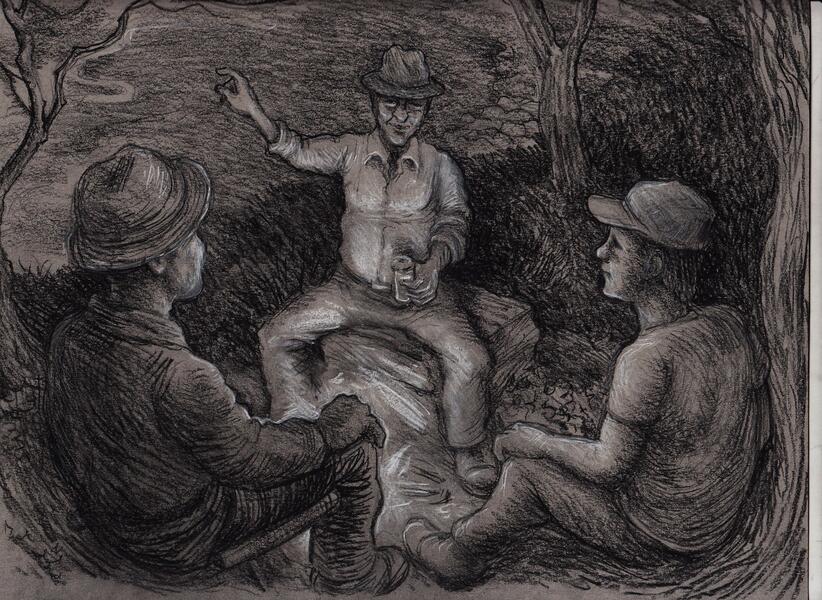 Illustration Hammons telling a story.jpgThis illustration by Tom Chalkly is part of a series used to describe how Sherman Hammons, a backwoodsman, would visit Dave Bing and his father’s campsite. Years later, Hammons would change Bing’s life when he played a “strange weird, archaic, out of this world tune,” on a banjo sending Bing and his brothers on a lifelong excursion through West Virginia’s rich old time music. Today Dave Bing is one of the last to learn from the old timers like Hammons and stands as arguably the ambassador of West Virginia Old Time music.
Illustration Hammons telling a story.jpgThis illustration by Tom Chalkly is part of a series used to describe how Sherman Hammons, a backwoodsman, would visit Dave Bing and his father’s campsite. Years later, Hammons would change Bing’s life when he played a “strange weird, archaic, out of this world tune,” on a banjo sending Bing and his brothers on a lifelong excursion through West Virginia’s rich old time music. Today Dave Bing is one of the last to learn from the old timers like Hammons and stands as arguably the ambassador of West Virginia Old Time music. -
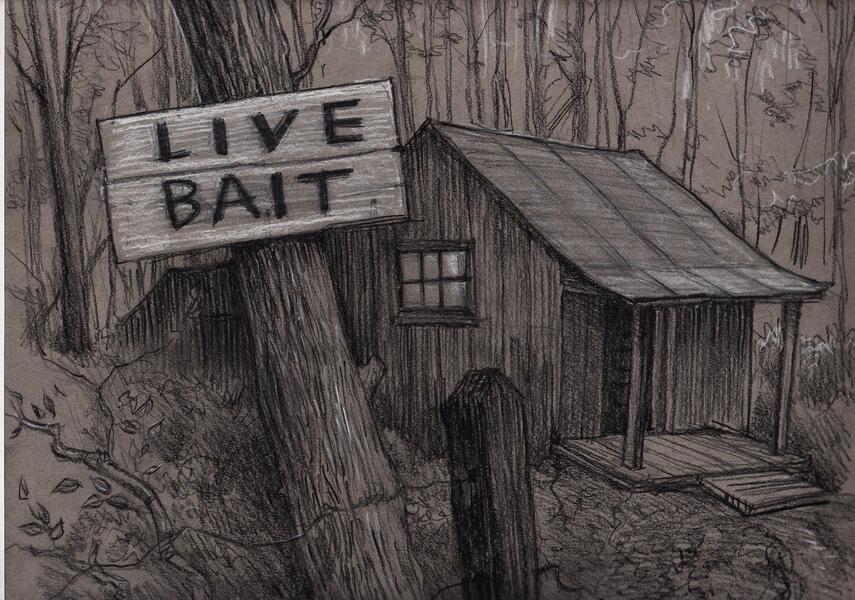 Sherman's CabinSherman's shack served as a backwoods salon where the old man would hold court to an odd selection -- a poet, an academic, some wry locals and musicians. By the time I got there, Sherman was two decades dead and the shack was rotting back into the ground with much of his furnishings crumbling with it. I spent time filming this historic wreckage. I love how this drawing captures the charm of how the cabin looked to Dave Bing.
Sherman's CabinSherman's shack served as a backwoods salon where the old man would hold court to an odd selection -- a poet, an academic, some wry locals and musicians. By the time I got there, Sherman was two decades dead and the shack was rotting back into the ground with much of his furnishings crumbling with it. I spent time filming this historic wreckage. I love how this drawing captures the charm of how the cabin looked to Dave Bing. -
The Last Season SizzlesThe Last Season, Highlight Reel
-
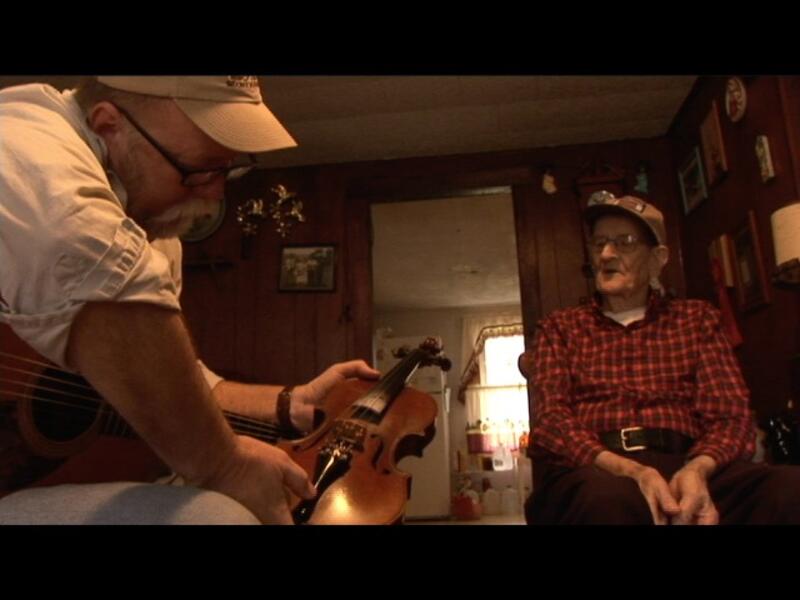 The intro pic 4.jpgIt soon became evident that I was doing my own field work with my camera and mics, which was just fine by me. I always wanted to do field work, going back to my college days. Dave Bing served as a tour guide as he traveled among amazing musicians in the far reaches of West Virginia and England (where I also tagged along). Seen here is Lester McCumbers. At 91 he was the oldest renown fiddler in West Virginia. Some of his fiddles he made from trees in his backyard, one from the floorboards from his kitchen. It was an honor to record him and he died two years later. This was the last time he played for an extended period.
The intro pic 4.jpgIt soon became evident that I was doing my own field work with my camera and mics, which was just fine by me. I always wanted to do field work, going back to my college days. Dave Bing served as a tour guide as he traveled among amazing musicians in the far reaches of West Virginia and England (where I also tagged along). Seen here is Lester McCumbers. At 91 he was the oldest renown fiddler in West Virginia. Some of his fiddles he made from trees in his backyard, one from the floorboards from his kitchen. It was an honor to record him and he died two years later. This was the last time he played for an extended period. -
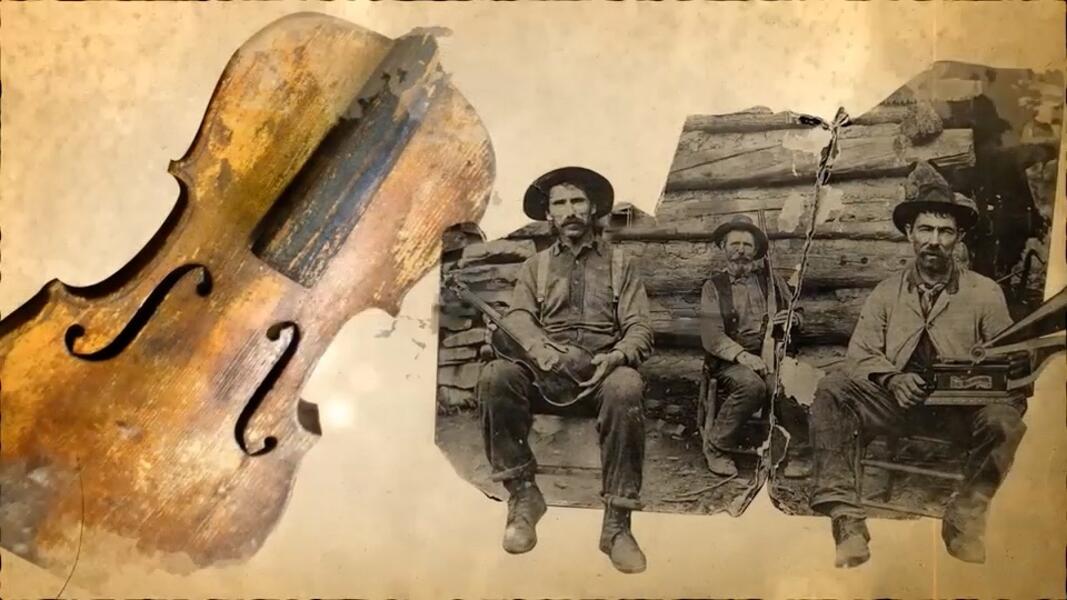 Hammons Family GraphicI am committed to integrating innovative graphics into my documentaries. I believe that people get if not bored, they at least appreciate a change in scenery. This pieced helped me answer a nagging question -- how to explain Old Time. This was particularly finicky since the term is rather open ended. It pre-dates bluegrass, which was a rather modern invention and the definition varies from musician to musician. So the best way, I figured, was to embrace the vagueness and allow the exploration to be part of the definition. Working with Artist Adam Bender, we pulled from archival photos. To the right we see the oldest photo of the Hammons family, found in The Folklife Center at the Library of Congress. I spent days over several years in there, listening to recordings and culling photographs. This photos with the family members holding a rifle, a fiddle and a gramophone was iconic and you got to wonder about the photographer who shot it.
Hammons Family GraphicI am committed to integrating innovative graphics into my documentaries. I believe that people get if not bored, they at least appreciate a change in scenery. This pieced helped me answer a nagging question -- how to explain Old Time. This was particularly finicky since the term is rather open ended. It pre-dates bluegrass, which was a rather modern invention and the definition varies from musician to musician. So the best way, I figured, was to embrace the vagueness and allow the exploration to be part of the definition. Working with Artist Adam Bender, we pulled from archival photos. To the right we see the oldest photo of the Hammons family, found in The Folklife Center at the Library of Congress. I spent days over several years in there, listening to recordings and culling photographs. This photos with the family members holding a rifle, a fiddle and a gramophone was iconic and you got to wonder about the photographer who shot it. -
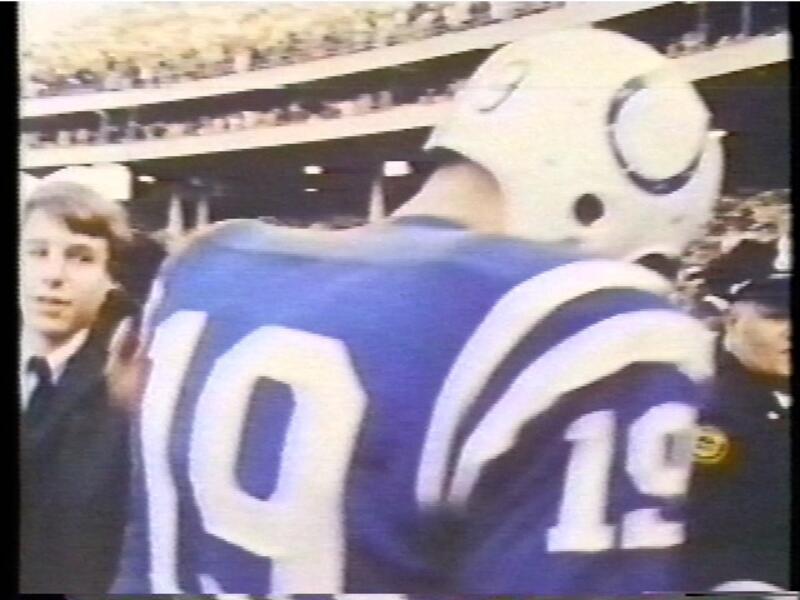 Unitas.jpgThere was a lot of archival footage in The Last Season -- all of which was attained rightfully. As my first film, I didn't know how far I could go. When we started, I thought if I could convince Wild Bill Hagy to do an onsite interview then that would be enough. But I kept pushing, interviewing sports figures from Brookes Robinson to Johnny Unitas. (Apparently we got the last Unitas interview before his death) This scavenger hunt process appeals to my love of research. The archival footage was found through the college at the Babe Ruth museum, which had rights to the locally shot footage.
Unitas.jpgThere was a lot of archival footage in The Last Season -- all of which was attained rightfully. As my first film, I didn't know how far I could go. When we started, I thought if I could convince Wild Bill Hagy to do an onsite interview then that would be enough. But I kept pushing, interviewing sports figures from Brookes Robinson to Johnny Unitas. (Apparently we got the last Unitas interview before his death) This scavenger hunt process appeals to my love of research. The archival footage was found through the college at the Babe Ruth museum, which had rights to the locally shot footage. -
https://vimeo.com/183767285Password Crooked Fiddler This documentary took on three incarnations. the original was about 80 minutes. The Shortest, Walking the Crooked Tune, which played at a fringe film festival in Paris was cut down to 15 minutes. I think this is my inner-journalist that allows me to kill my babies in order to remake hard-labored features into shorts.
-
Fiddle MakingDave's handcrafted fiddles required a whole another level of focus. This was slow tedious work, but one that Dave turned into meditation and one that lent to some nice filmic opportunities. Through my years visiting Dave Bing I would always set up in his workshop recording how Dave made fragile fiddles from chunks of wood with hand tools. I used several cameras. The Bolex, I will admit was my favorite. There is so much I love about shooting this process, the glint of the light off the chisels, the detail in the calibers and of course the grain in the wood. I could easily do an entire piece on Dave's process. In the film, his fiddle making was used as a reveal as it was introduced late in the film just when the viewers thought they got to know him.



















































